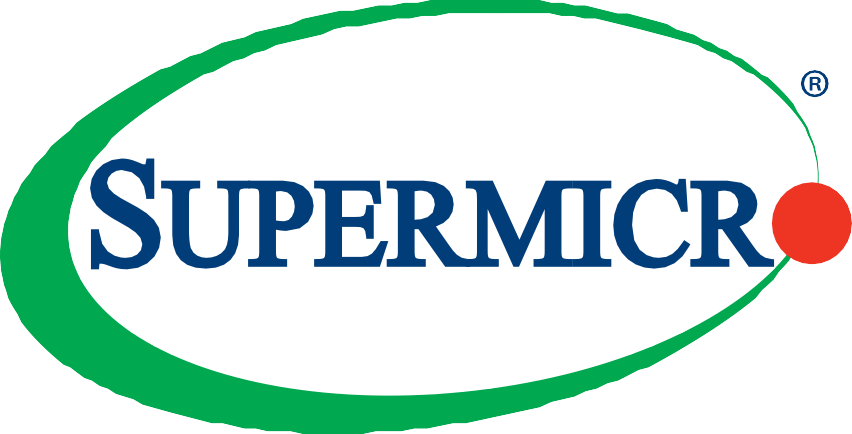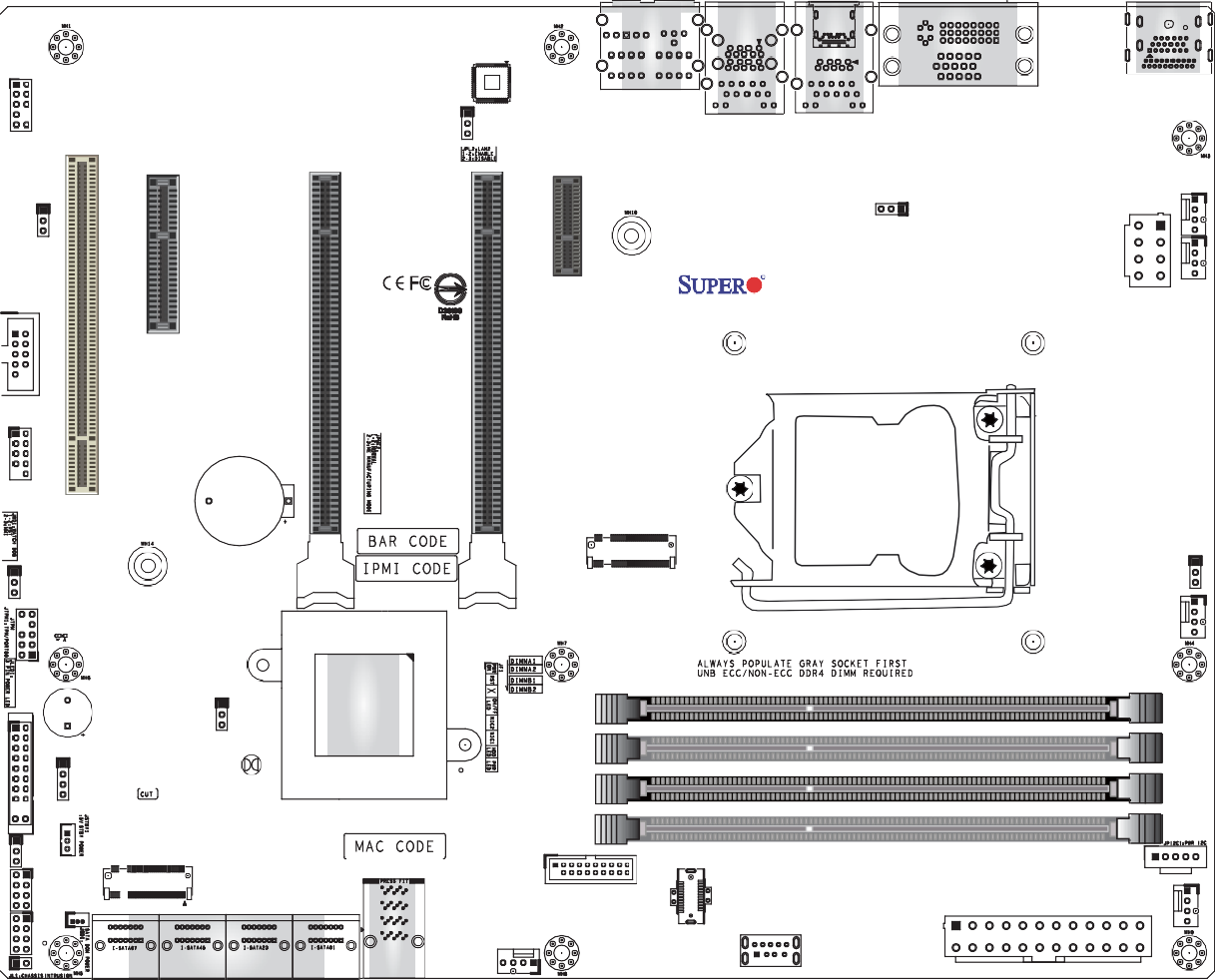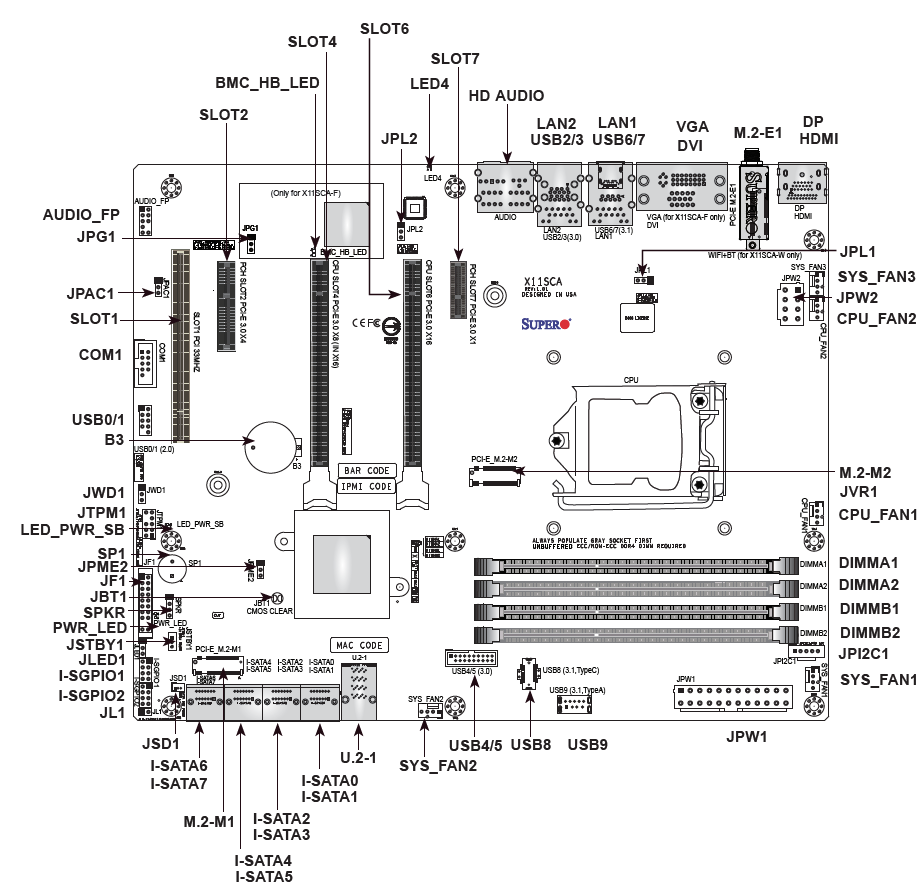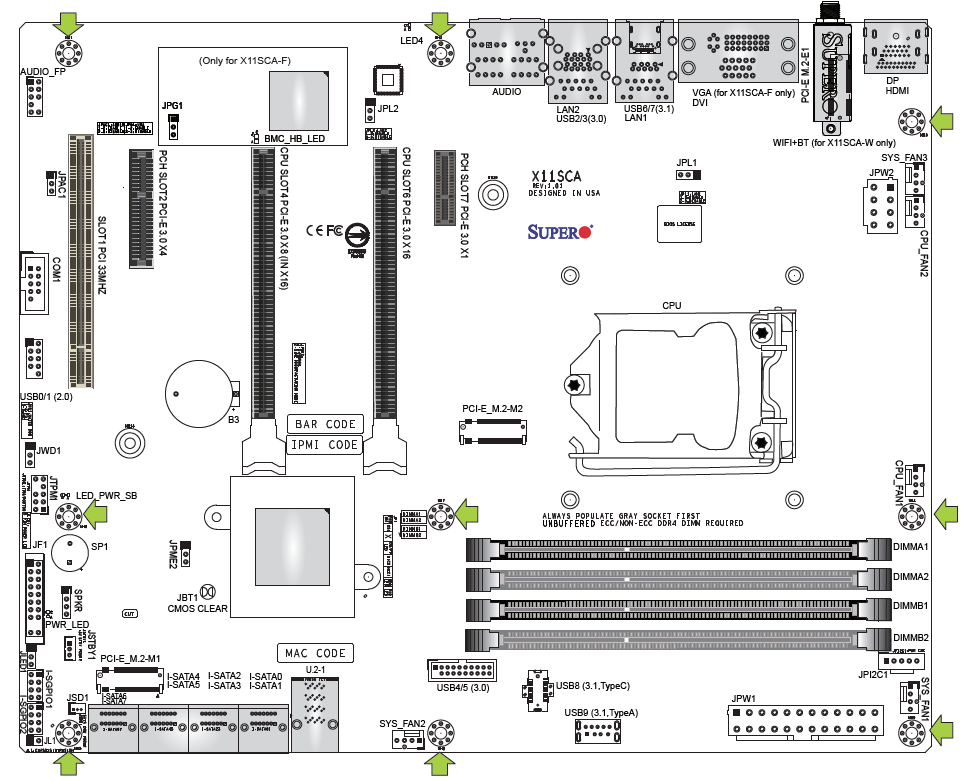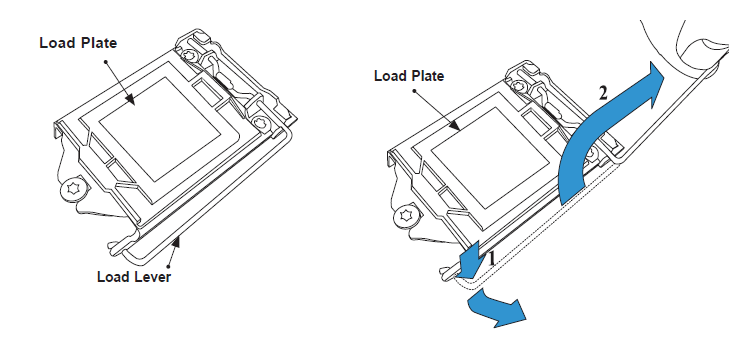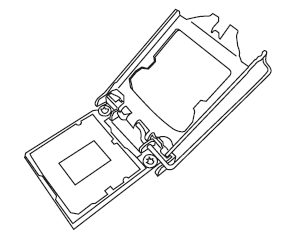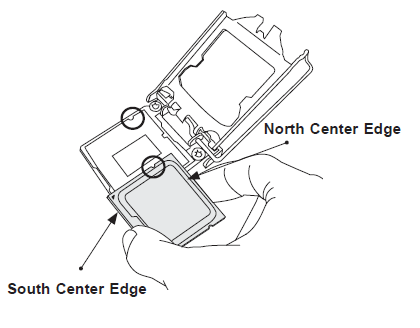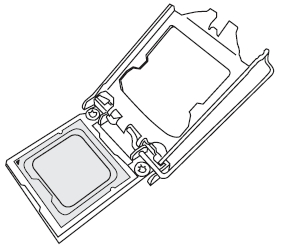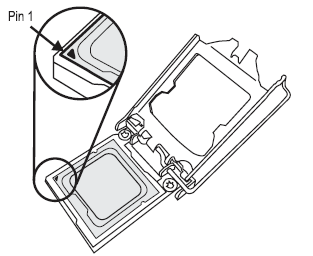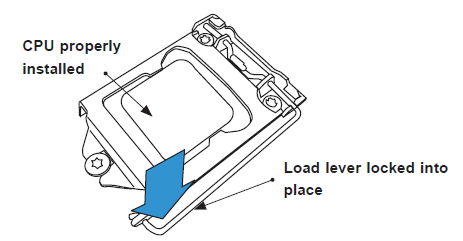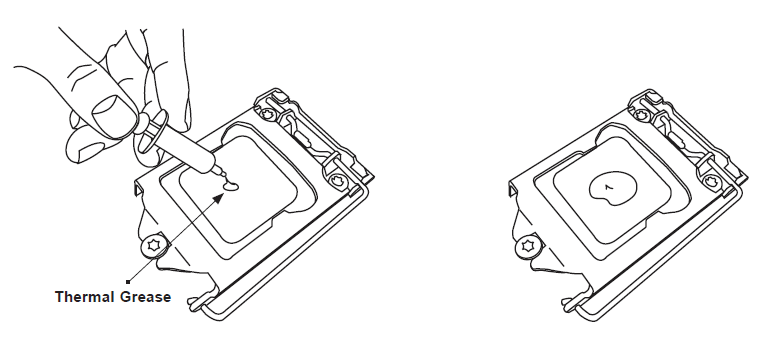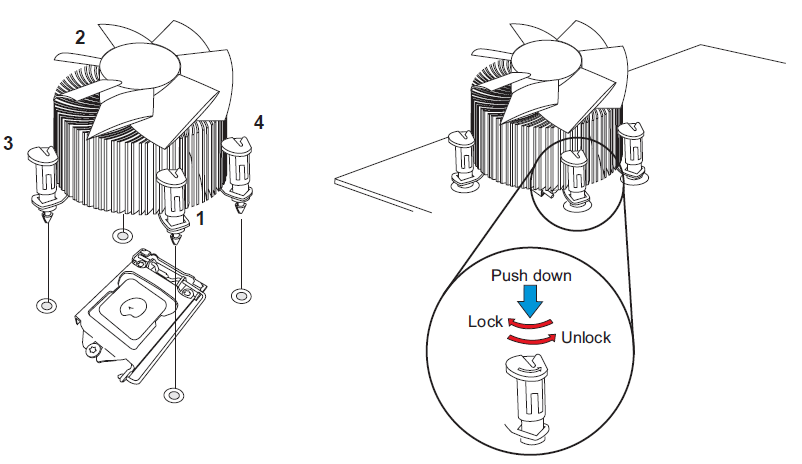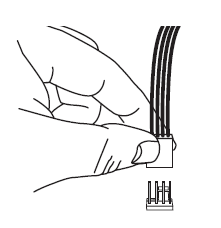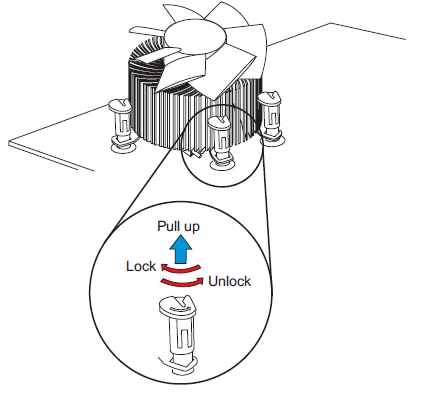Supermicro X11SCA, X11SCA-W, X11SCA-F
The information in this user’s manual has been carefully reviewed and is believed to be accurate. The vendor assumes no responsibility for any inaccuracies that may be contained in this document, and makes no commitment to update or to keep current the information in this manual, or to notify any person or organization of the updates. Please Note: For the most up-to-date version of this manual, please see our website at www.supermicro.com
Super Micro Computer, Inc. “Supermicro” reserves the right to make changes to the product described in this manual at any time and without notice. This product, including software and documentation, is the property of Supermicro and/ or its licensors, and is supplied only under a license. Any use or reproduction of this product is not allowed, except as expressly permitted by the terms of said license.
IN NO EVENT WILL Super Micro Computer, Inc. BE LIABLE FOR DIRECT, INDIRECT, SPECIAL, INCIDENTAL, SPECULATIVE OR CONSEQUENTIAL DAMAGES ARISING FROM THE USE OR INABILITY TO USE THIS PRODUCT OR DOCUMENTATION, EVEN IF ADVISED OF THE POSSIBILITY OF SUCH DAMAGES. IN PARTICULAR, SUPER MICRO COMPUTER, INC. SHALL NOT HAVE LIABILITY FOR ANY HARDWARE, SOFTWARE, OR DATA STORED OR USED WITH THE PRODUCT, INCLUDING THE COSTS OF REPAIRING, REPLACING, INTEGRATING, INSTALLING OR RECOVERING SUCH HARDWARE, SOFTWARE, OR DATA.
Any disputes arising between manufacturer and customer shall be governed by the laws of Santa Clara County in the State of California, USA. The State of California, County of Santa Clara shall be the exclusive venue for the resolution of any such disputes. Supermicro’s total liability for all claims will not exceed the price paid for the hardware product.
FCC Statement: This equipment has been tested and found to comply with the limits for a Class B digital device pursuant to Part 15 of the FCC Rules. These limits are designed to provide reasonable protection against harmful interference when the equipment is operated in a consumer environment or residential installation. This equipment generates, uses, and can radiate radio frequency energy and, if not installed and used in accordance with the manufacturer’s instruction manual, may cause harmful interference with radio communications. Operation of this equipment in a residential area is likely to cause harmful interference, in which case you will be required to correct the interference at your own expense.
California Best Management Practices Regulations for Perchlorate Materials: This Perchlorate warning applies only to products containing CR (Manganese Dioxide) Lithium coin cells. Perchlorate Material-special handling may apply. See www.dtsc.ca.gov/hazardouswaste/perchlorate
The products sold by Supermicro are not intended for and will not be used in life support systems, medical equipment, nuclear facilities or systems, aircraft, aircraft devices, aircraft/emergency communication devices or other critical systems whose failure to perform be reasonably expected to result in significant injury or loss of life or catastrophic property damage. Accordingly, Supermicro disclaims any and all liability, and should buyer use or sell such products for use in such ultra-hazardous applications, it does so entirely at its own risk. Furthermore, buyer agrees to fully indemnify, defend and hold Supermicro harmless for and against any and all claims, demands, actions, litigation, and proceedings of any kind arising out of or related to such ultra-hazardous use or sale.
Release Date: February 02, 2021
Unless you request and receive written permission from Super Micro Computer, Inc., you may not copy any part of this document. Information in this document is subject to change without notice. Other products and companies referred to herein are trademarks or registered trademarks of their respective companies or mark holders.
About This Manual
This manual is written for system integrators, IT technicians, and knowledgeable end users. It provides information for the installation and use of the X11SCA/-W/-F motherboard.
About This Motherboard
The X11SCA/-W/-F motherboard supports a single Intel® Xeon® E, Core™ i3/i5/i7/i9, Pentium®, and Celeron® series processor in an LGA 1151 (H4) socket. With the Intel C246 chipset, this motherboard supports DDR4 2666 MHz memory, SATA 3.0 ports, PCIe 3.0 slots,
M.2 slots, 1G LAN ports, and IPMI. This motherboard offers a cost-effective WIO server solution and is ideal for 1U/2 AOC applications. Please note that this motherboard is intended to be installed and serviced by professional technicians only. For processor/memory updates, please refer to our website at http://www.supermicro.com/products/
Warning! Indicates high voltage may be encountered when performing a procedure.
Introduction
Congratulations on purchasing your computer motherboard from an industry leader. Supermicro motherboards are designed to provide you with the highest standards in quality and performance. Several important parts that are included with the motherboard are listed below. If anything listed is damaged or missing, please contact your retailer.
Checklist (For Single Color Box Packing only)
|
Main Parts List |
||
|
Description |
Part Number |
Quantity |
|
Supermicro Motherboard |
X11SCA/-W/-F |
1 |
|
SATA Cables |
CBL-0044L |
6 |
|
Quick Reference Guide |
MNL-2087-QRG |
1 |
|
IO Shield |
MCP-260-00122-0N |
1 |
|
M.2 Holder |
MCP-450-00005-0B |
1 |
|
Antenna (X11SCA-W only) |
CBL-ANTDB-SMA |
2 |
Important Links
For your system to work properly, please follow the links below to download all necessary drivers/utilities and the user’s manual for your server.
- Supermicro product manuals: http://www.supermicro.com/support/manuals/
- Product drivers and utilities: https://www.supermicro.com/wftp/driver/
- Product safety info: http://www.supermicro.com/about/policies/safety_information.cfm
- A secure data deletion tool designed to fully erase all data from storage devices can be found at our website: https://www.supermicro.com/about/policies/disclaimer.cfm?url=/ wftp/utility/Lot9_Secure_Data_Deletion_Utility/
- If you have any questions, please contact our support team at: [email protected]m
This manual may be periodically updated without notice. Please check the Supermicro website for possible updates to the manual revision level.
Figure 1-1. X11SCA Motherboard Image
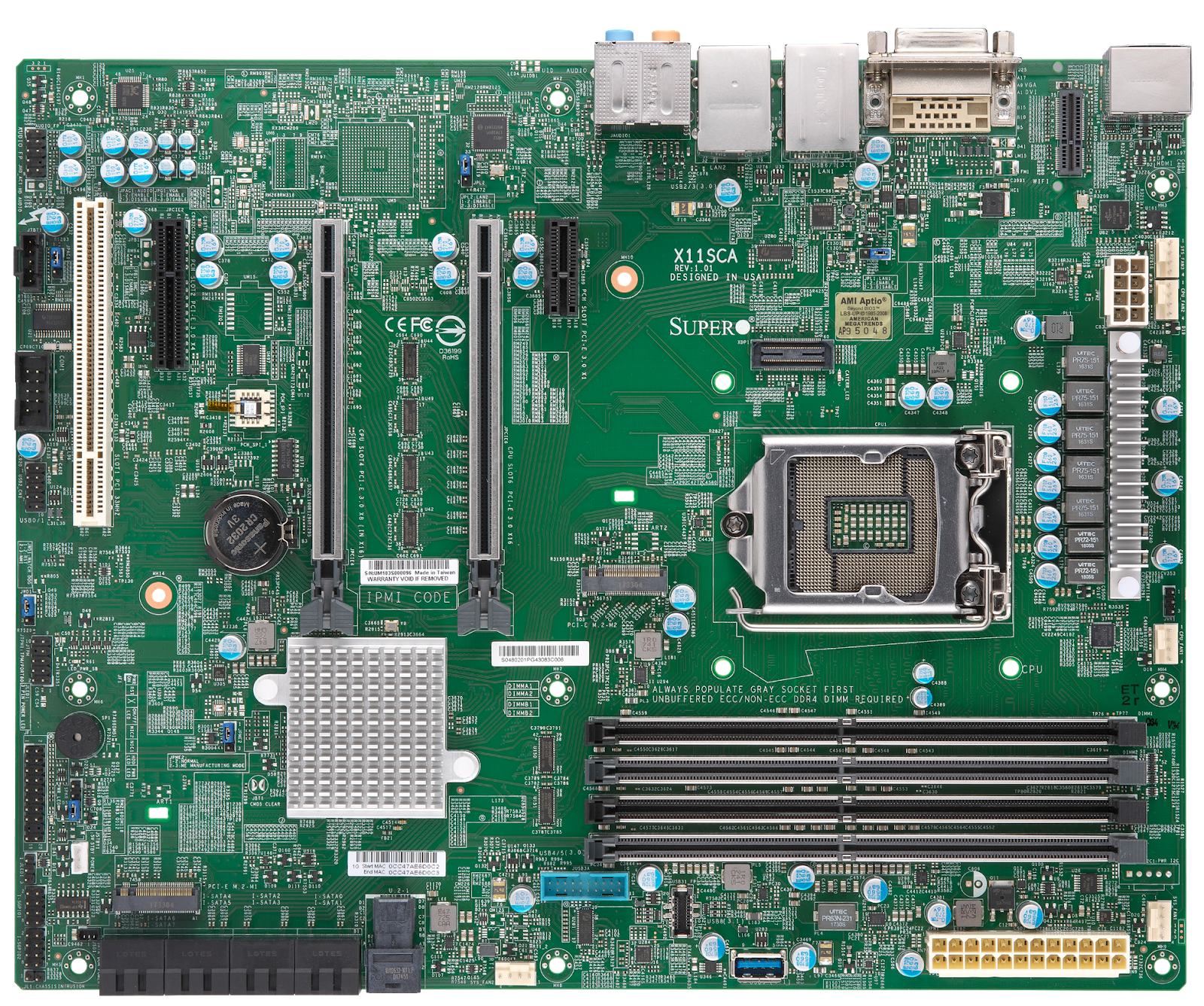
|
Headquarters |
|
|
Address: |
Super Micro Computer, Inc. |
|
980 Rock Ave. |
|
|
San Jose, CA 95131 U.S.A. |
|
|
Tel: |
+1 (408) 503-8000 |
|
Fax: |
+1 (408) 503-8008 |
|
Email: |
|
|
[email protected] (Tec |
|
|
Website: |
|
|
Europe |
|
|
Address: |
Super Micro Computer B.V. |
|
Het Sterrenbeeld 28, 5215 ML |
|
|
‘s-Hertogenbosch, The Netherlands |
|
|
Tel: |
+31 (0) 73-6400390 |
|
Fax: |
+31 (0) 73-6416525 |
|
Email: |
[email protected] (General Informa |
|
[email protected] (Technical Sup |
|
|
[email protected] (Customer Suppo |
|
|
Website: |
Note: All graphics shown in this manual were based upon the
PCB revision avail- able at the time of publication of the manual. The motherboard you received may or may not look exactly the same as the graphics shown in this manual
Figure 1-2. X11SCA-W Motherboard Image
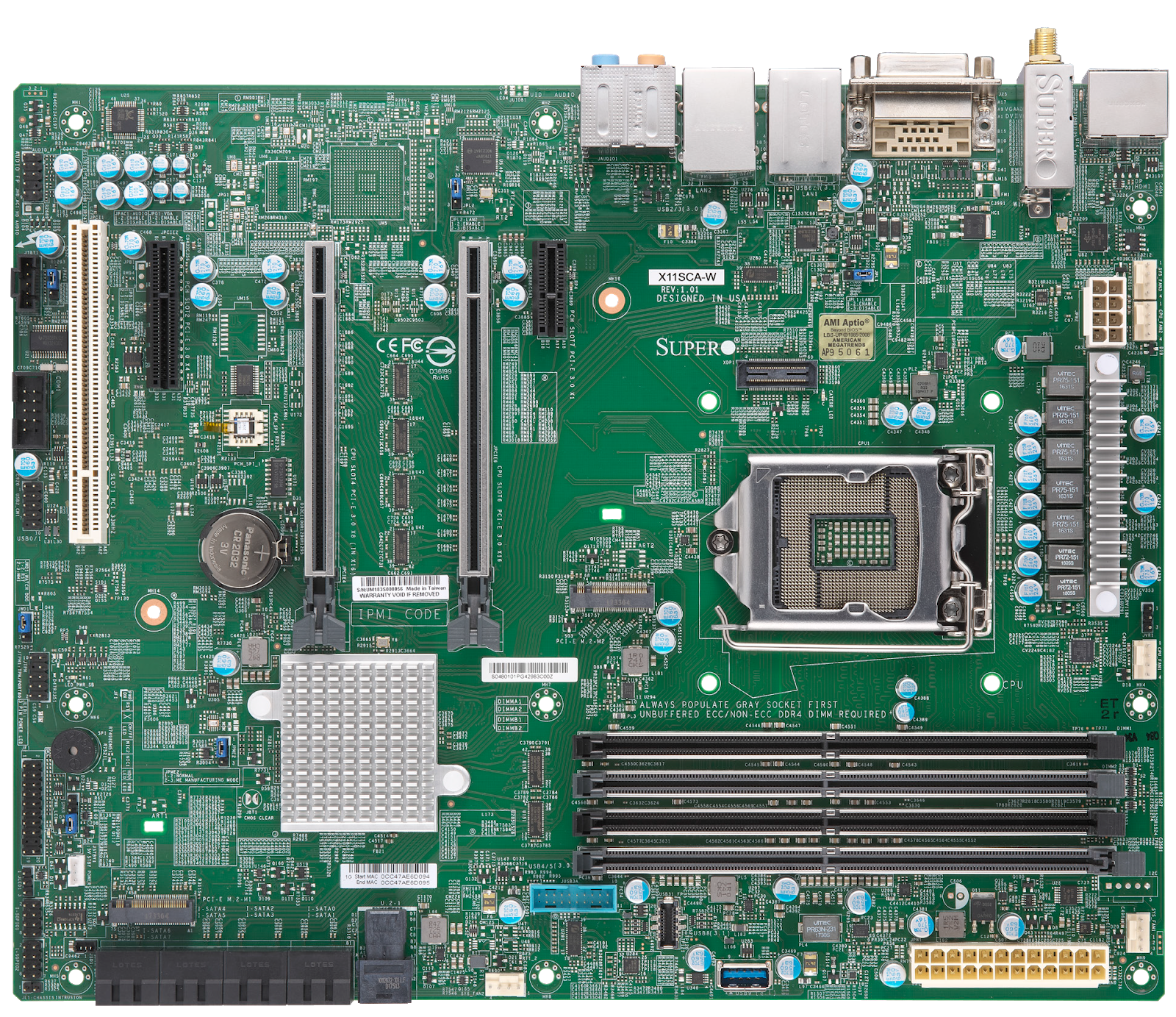
Note: All graphics shown in this manual were based upon the latest PCB revision avail- able at the time of publication of the manual. The motherboard you received may or may not look exactly the same as the graphics shown in this manual.
Figure 1-2. X11SCA-F Motherboard Image
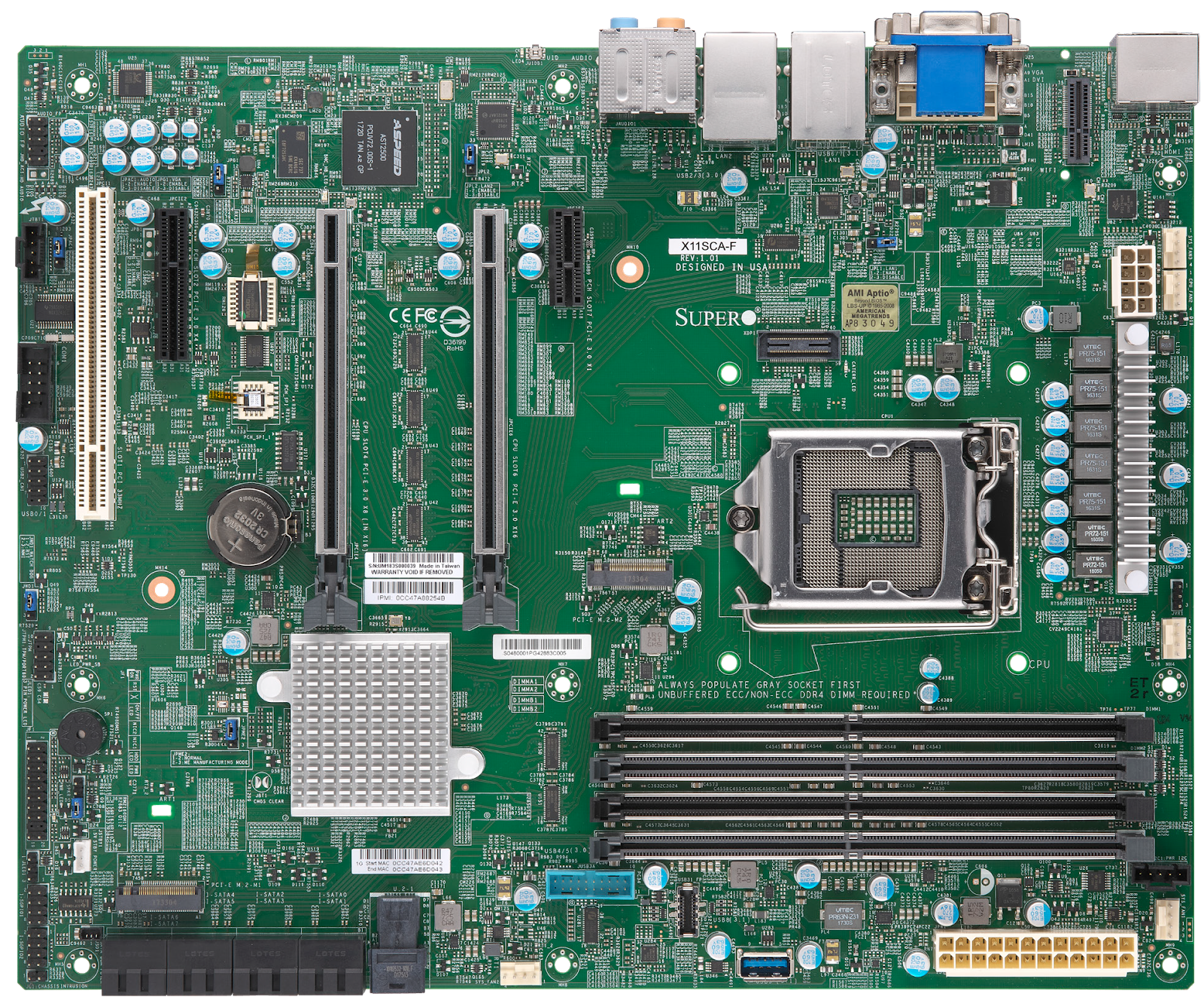
Note: All graphics shown in this manual were based upon the latest PCB revision available at the time of publication of the manual. The motherboard you received may or may not look exactly the same as the graphics shown in this manual.
Figure 1-3. X11SCA Motherboard Layout
Note: Components not documented are for internal testing only.
Figure 1-3. X11SCA-W Motherboard Layout
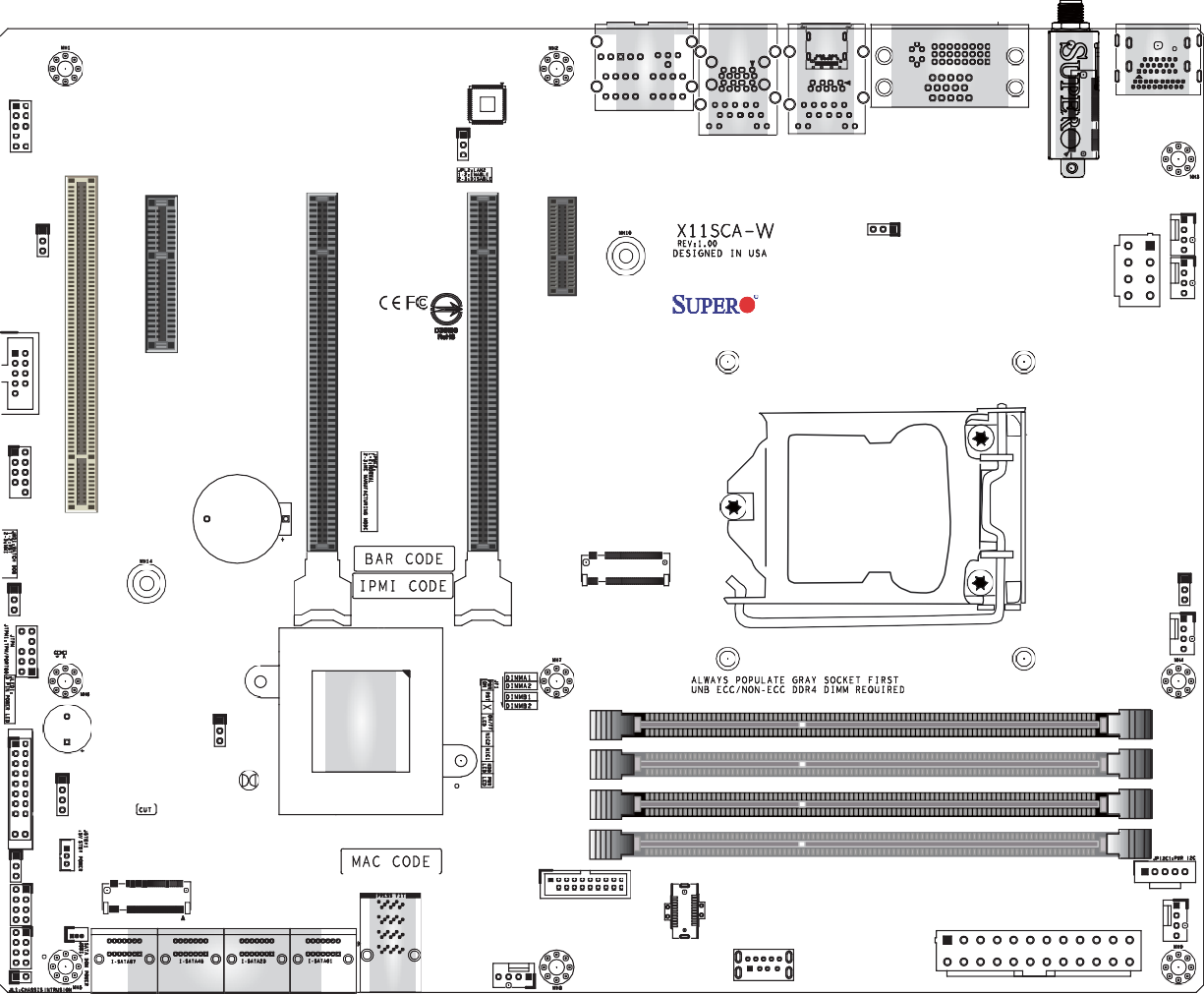
Note: Components not documented are for internal testing only.
Figure 1-3. X11SCA-F Motherboard Layout
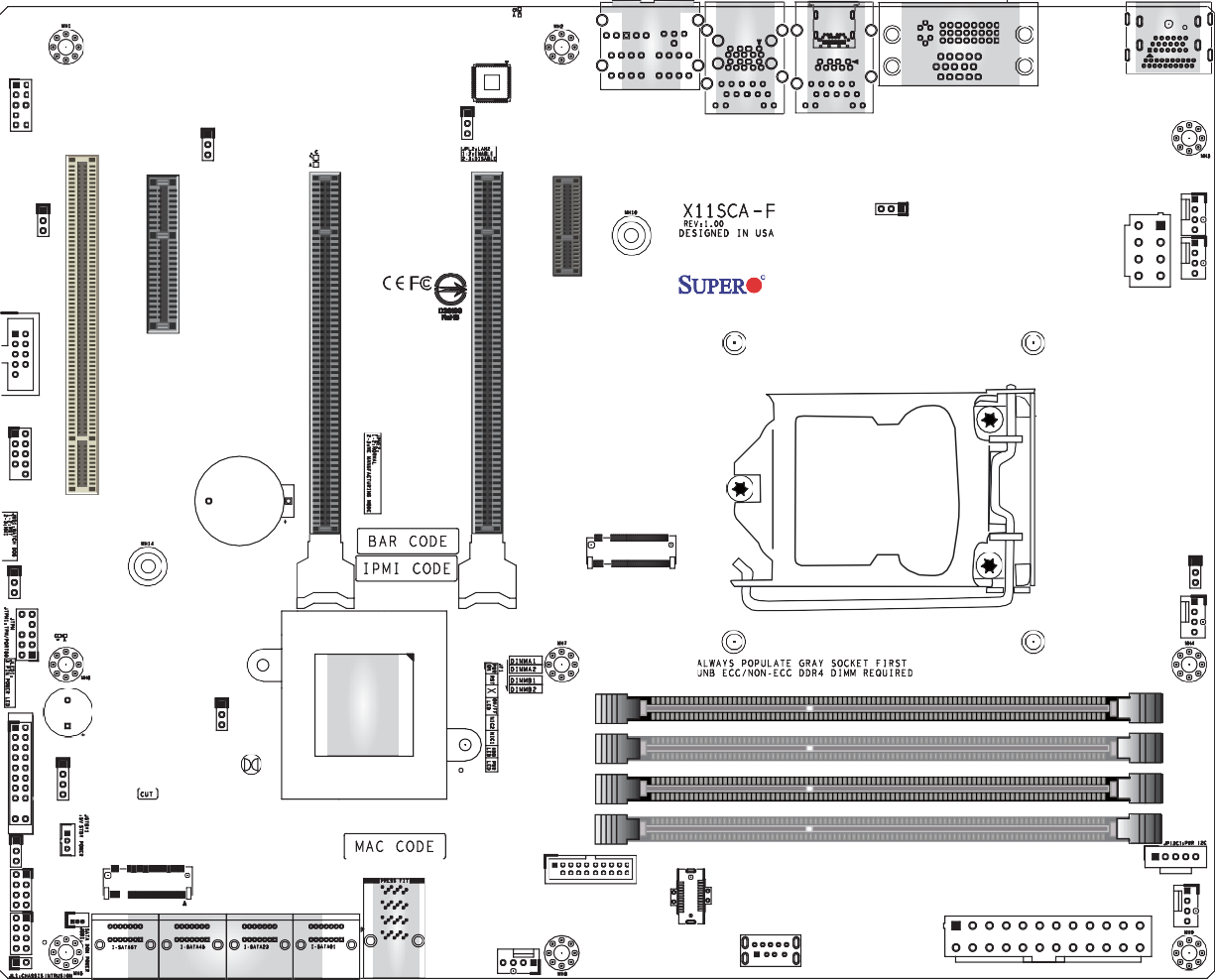
Note: Components not documented are for internal testing only.
Quick Reference
Notes:
- See Chapter 2 for detailed information on jumpers, I/O ports, and JF1 front panel connections.
- “
 ” indicates the location of Pin 1.
” indicates the location of Pin 1. - Jumpers/LED indicators not indicated are used for testing only.
- When PWR_LED (Onboard Power LED indicator) is on, system power is on. Unplug the power cable before installing or removing any components.
Quick Reference Table
|
Jumper |
Description |
Default Setting |
|
JBT1 |
Clear CMOS |
Short: Clear CMOS Open: Normal |
|
JPAC1 |
Audio Enable |
Pins 1-2 (Enabled) |
|
JPG1 |
BMC GFX Chip Disable (X11SCA-F only) |
Pins 1-2 (Enabled) |
|
JPL1 |
LAN1 Enable |
Pins 1-2 (Enabled) |
|
JPL2 |
LAN2 Enable |
Pins 1-2 (Enabled) |
|
JPME2 |
Manufacturing Mode Select |
Pins 1-2 (Normal) |
|
JWD1 |
Watch Dog Enable |
Pins 1-2 (Reset) |
|
LED |
Description |
Status |
|
BMC_HB_LED |
BMC Heartbeat LED (X11SCA-F only) |
Green Blinking: Normal |
|
LED4 |
UID LED (X11SCA-F only) |
Blue: Unit Identified |
|
LED_PWR_SB |
Standby Power LED |
Green: P3V3 Standby Power Ready |
|
PWR_LED |
Onboard Power LED |
Green: Power On |
|
Connector |
Description |
|
AUDIO_FP |
Front Panel Audio Header |
|
B3 |
Onboard Battery |
|
COM1 |
COM1 Header |
|
CPU SLOT4 PCI-E 3.0 x8 (IN x16) |
PCIe x16 Slot (PCIe 3.0 x8 link) |
|
CPU SLOT6 PCI-E 3.0 x16 |
PCIe x16 Slot (PCIe 3.0 x16 link; x8 link when SLOT4 is in use) |
|
PCH SLOT7 PCI-E 3.0 x1 |
PCIe x1 Slot |
|
PCH SLOT2 PCI-E 3.0 x4 |
PCIe x4 Slot (shared with M.2-M1) |
|
PCI SLOT1 33MHz |
PCI Slot, 32 Bit/ 33 MHz with 5V single voltage |
|
DP |
Back Panel DisplayPort |
|
DVI |
Digital Video Interface |
|
CPU_FAN1~2 |
CPU Fan Headers |
|
SYS_FAN1~3 |
System Fan Headers |
|
HD AUDIO |
Back Panel HD Audio Connectors |
|
HDMI |
Back Panel HDMI Port |
|
I-SATA0 ~ I-SATA7 |
SATA 3.0 Ports via Intel PCH (6Gb/s) |
|
I-SGPIO 1/2 |
Serial Link General Purpose I/O Connection Headers for I-SATA 3.0 connections (I-SGPIO1 is for I-SATA0~3; I-SGPIO2 is for I-SATA4~5) |
|
JF1 |
Front Control Panel Header |
|
JL1 |
Chassis Intrusion Header |
|
JLED1 |
3-pin Power LED Indicator Header |
|
JPW1 |
24-pin ATX Main Power Connector (Required) |
Motherboard Features
|
Motherboard Features |
|
|
CPU |
|
|
|
|
Memory |
|
|
|
|
DIMM Size |
|
Note 1: Memory speed support depends on the processor used in the system. Note 2: For the latest CPU/memory updates, please refer to our website at http://www.super- micro.com/products/motherboard. |
|
|
Chipset |
|
|
|
|
Expansion Slots |
|
|
|
|
Network |
|
|
|
|
Baseboard Management Controller (BMC) |
|
|
|
|
Graphics |
|
|
|
|
I/O Devices |
|
|
|
|
|
|
|
|
Peripheral Devices |
|
|
BIOS |
|
|
Power Management |
|
|
System Health Monitoring |
|
|
Fan Control |
|
|
System Management |
|
|
LED Indicators |
|
|
Other |
|
|
Dimensions |
|
Note 1: The CPU maximum thermal design power (TDP) is subject to chassis and heatsink cooling restrictions. For proper thermal management, please check the chassis and heatsink specifications for proper CPU TDP sizing.
Note 2: For IPMI configuration instructions, please refer to the Embedded IPMI Configuration User’s Guide available at http://www.supermicro.com/support/manuals/
Chipset Block Diagram
Note: This is a general block diagram and may not exactly represent the features on your motherboard. See the previous pages for the actual specifications of your motherboard.
Processor and Chipset Overview
Built upon the functionality and capability of the Intel Xeon E, Core i3/i5/i7/i9, Celeron, and Pentium series processors (Socket LGA 1151) and the Intel C246, the X11SCA/-W/-F motherboard offers maximum I/O expandability, energy efficiency, and data reliability in a 14-nm process architecture. It is optimized for all workstation applications, for example, 3D modeling, rendering, video editing, engineering simulation, and automation.
The Intel Xeon-E and PCH C246 platform supports the following features:
- ACPI Power Management
- Intel Turbo Boost Technology 2.0, Power Monitoring/Power Control, and Platform Power Control
- Adaptive Thermal Management/Monitoring
- PCIe 3.0, SATA 3.0 with transfer rates of up to 6 Gb/s, xHCI USB w/SuperSpeed 3.1
- System Management Bus (SMBus) Specification, Version 2.0
- Intel Trusted Execution Technology (Intel TXT)
- Intel Rapid Storage Technology
- Intel Virtualization Technology for Directed I/O (Intel VT-d)
Special Features
This section describes the health monitoring features of the X11SCA/-W/-F motherboard. The motherboard has an onboard System Hardware Monitor chip that supports system health monitoring.
Recovery from AC Power Loss
The Basic I/O System (BIOS) provides a setting that determines how the system will respond when AC power is lost and then restored to the system. You can choose for the system to remain powered off (in which case you must press the power switch to turn it back on), or for it to automatically return to the power-on state. See the Advanced BIOS Setup section for this setting. The default setting is Last State.
System Health Monitoring
Onboard Voltage Monitors (X11SCA-F only)
The onboard voltage monitor will continuously scan crucial voltage levels. Once a voltage becomes unstable, it will give a warning or send an error message to the screen. Users can adjust the voltage thresholds to define the sensitivity of the voltage monitor. Real time readings of these voltage levels are all displayed in BIOS.
Fan Status Monitor with Firmware Control
The system health monitor chip can check the RPM status of a cooling fan. The CPU and chassis fans are controlled by BIOS Thermal Management.
Environmental Temperature Control (X11SCA-F only)
System health sensors monitor temperatures and voltage settings of onboard processors and the system in real time via the IPMI interface. Whenever the temperature of the CPU or the system exceeds a user-defined threshold, system/CPU cooling fans will be turned on to prevent the CPU or the system from overheating
Note: To avoid possible system overheating, please be sure to provide adequate airflow to your system.
System Resource Alert
This feature is available when used with SuperDoctor 5 in the Windows OS or in the Linux environment. SuperDoctor is used to notify the user of certain system events. For example, you can configure SuperDoctor to provide you with warnings when the system temperature, CPU temperatures, voltages, and fan speeds go beyond a predefined range.
ACPI Features
ACPI stands for Advanced Configuration and Power Interface. The ACPI specification defines a flexible and abstract hardware interface that provides a standard way to integrate power management features throughout a computer system, including its hardware, operating system and application software. This enables the system to automatically turn on and off peripherals such as CD-ROMs, network cards, hard disk drives and printers.
In addition to enabling operating system-directed power management, ACPI also provides a generic system event mechanism for Plug and Play, and an operating system-independent interface for configuration control. ACPI leverages the Plug and Play BIOS data structures, while providing a processor architecture-independent implementation that is compatible with appropriate Windows operating systems.
Power Supply
As with all computer products, a stable power source is necessary for proper and reliable operation. It is even more important for processors that have high CPU clock rates.
The X11SCA/-W/-F motherboard accommodates 24-pin ATX power supplies. Although most power supplies generally meet the specifications required by the CPU, some are inadequate. In addition, one 12V 8-pin power connection is also required to ensure adequate power supply to the system.

Warning: To avoid damaging the power supply or the motherboard, be sure to use a power supply that contains a 24-pin and 8-pin power connector. Be sure to connect the power supplies to the 24-pin power connector (JPW1), and the 8-pin power con- nector (JPW2) on the motherboard. Failure in doing so may void the manufacturer warranty on your power supply and motherboard.
It is strongly recommended that you use a high quality power supply that meets ATX power supply Specification 2.02 or above. It must also be SSI compliant.
Serial Port
The X11SCA/-W/-F motherboard supports one serial communication connection. COM port header 1 (COM1) can be used for input/output. The UART provides legacy speeds with a baud rate of up to 115.2 Kbps.
Installation
Static-Sensitive Devices
Electrostatic Discharge (ESD) can damage electronic components. To prevent damage to your motherboard, it is important to handle it very carefully. The following measures are generally sufficient to protect your equipment from ESD.
Precautions
- Use a grounded wrist strap designed to prevent static discharge.
- Touch a grounded metal object before removing the board from the antistatic bag.
- Handle the board by its edges only; do not touch its components, peripheral chips, memory modules or gold contacts.
- When handling chips or modules, avoid touching their pins.
- Put the motherboard and peripherals back into their antistatic bags when not in use.
- For grounding purposes, make sure your computer chassis provides excellent conductivity between the power supply, the case, the mounting fasteners and the motherboard.
- Use only the correct type of onboard CMOS battery. Do not install the onboard battery upside down to avoid possible explosion.
Unpacking
The motherboard is shipped in antistatic packaging to avoid static damage. When unpacking the motherboard, make sure that the person handling it is static protected.
Motherboard Installation
All motherboards have standard mounting holes to fit different types of chassis. Make sure that the locations of all the mounting holes for both the motherboard and the chassis match. Although a chassis may have both plastic and metal mounting fasteners, metal ones are highly recommended because they ground the motherboard to the chassis. Make sure that the metal standoffs click in or are screwed in tightly.
Tools Needed
Location of Mounting Holes 
Notes:
- To avoid damaging the motherboard and its components, please do not use a force greater than 8 lb. inch on each mounting screw during motherboard installation.
- Some components are very close to the mounting holes. Please take precautionary measures to avoid damaging these components when installing the motherboard to the chassis.
Installing the Motherboard
- Locate the mounting holes on the motherboard. Refer to the previous page for the location.
- Locate the matching mounting holes on the chassis. Align the mounting holes on the motherboard against the mounting holes on the chassis
- Install standoffs in the chassis as needed.
- Make sure that the motherboard is securely placed in the chassis.
- Repeat Step 5 to insert the remaining screws into all mounting holes.
- Using the Phillips screwdriver, insert a Phillips head #6 screw into a mounting hole on the motherboard and its matching mounting hole on the chassis.
- Install the motherboard into the chassis carefully to avoid damaging other motherboard components.
Note: Images displayed are for illustration only. Your chassis or components might look different from those shown in this manual.
Processor and Heatsink Installation
Warning: When handling the processor package, avoid placing direct pressure on the label area of the fan.
Important:
- Always connect the power cord last, and always remove it before adding, removing or changing any hardware components. Make sure that you install the processor into the CPU socket before you install the CPU heatsink.
- If you buy a CPU separately, make sure that you use an Intel-certified multi-directional heatsink only.
- Make sure to install the motherboard into the chassis before you install the CPU heatsink.
- When receiving a motherboard without a processor pre-installed, make sure that the plastic CPU socket cap is in place and none of the socket pins are bent; otherwise, contact your retailer immediately.
- Refer to the Supermicro website for updates on CPU support.
Installing the LGA1151 Processor
- Press the load lever to release the load plate, which covers the CPU socket, from its locking position.

- Gently lift the load lever to open the load plate. Remove the plastic cap.

- Use your thumb and your index finger to hold the CPU at the North center edge and the South center edge of the CP.

- Align the CPU key that is the semi-circle cutouts against the socket keys. Once it is aligned, carefully lower the CPU straight down into the socket. Do not drop the CPU on the socket. Do not move the CPU horizontally or vertically.

- Do not rub the CPU against the surface or against any pins of the socket to avoid damaging the CPU or the socket.

- With the CPU inside the socket, inspect the four corners of the CPU to make sure that the CPU is properly installed.
- Use your thumb to gently push the load lever down to the lever lock.

Note: You can only install the CPU inside the socket in one direction. Make sure that it is properly inserted into the CPU socket before closing the load plate. If it doesn’t close properly, do not force it as it may damage your CPU. Instead, open the load plate again and double-check that the CPU is aligned properly.
Installing an Active CPU Heatsink with Fan
- Locate the CPU fan header (CPU_FAN1) on the motherboard.
- Position the heatsink so that the heatsink fan wires are closest to the CPU fan header and are not interfering with other components.
- Inspect the CPU fan wires to make sure they are routed through the bottom of the heatsink.
- Remove the thin layer of protective film from the heatsink. CPU overheating may occur if the protective film is not removed from the heatsink.
- Apply the proper amount of thermal grease on the CPU. If your heatsink came with a thermal pad, please ignore this step. Once the screws are tightened, plug the power cord into the CPU_FAN1 header.

- Align the four heatsink fasteners with the mounting holes on the motherboard. Gently push down the fasteners in a diagonal order (Example: #1 and #2, then #3 and #4) into the mounting holes until you hear a click. Then lock the fasteners by turning each one 90° clockwise.

- Once all four fasteners are secured, connect the heatsink fan wire connector to the CPU fan header.

Removing a Heatsink
Note: We do not recommend that the CPU or heatsink be removed. However, if you do need to remove the heatsink, please follow the instructions below to remove the heatsink and prevent damage done to the CPU or other components.
- Unplug the power connector from the power supply.
- Disconnect the heatsink fan connector from the CPU fan header.
- Gently press down each fastener cap and turn them 90°counter clockwise, then pull the fasteners upwards to loosen them.
- Remove the heatsink from the CPU.

Memory Support and Installation
Note: Check the Supermicro website for recommended memory modules.
Important: Exercise extreme care when installing or removing DIMM modules to pre- vent any possible damage.
Memory Support
The X11SCA/-W/-F motherboard supports up to 128GB of unbuffered, ECC/non-ECC DDR4 with speeds of up to 2666 MHz memory in four memory slots. Populating these DIMM slots with memory modules of the same type and size will result in interleaved memory, which will improve memory performance.
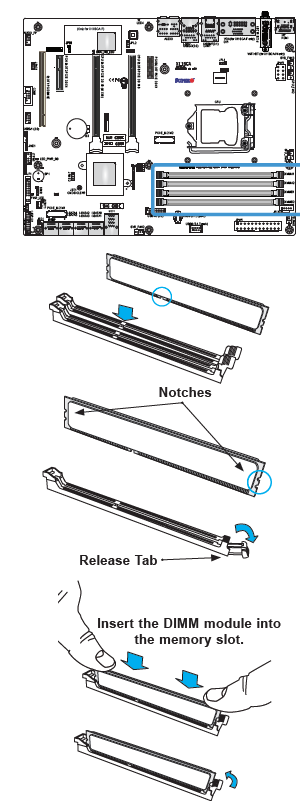
Installing DDR4 Memory
- Insert the desired number of DIMMs into the memory slots, starting with DIMMA2, then DIMMB2, DIMMA1, and DIMMB1. For the system to work properly, please use the memory modules of the same type and speed.
- Push the release tab outwards on the end of the DIMM slot to unlock it.
- Align the key of the DIMM module with the receptive point on the memory slot.
- Use two thumbs together to press the notches on both ends of the module straight down into the slot until the module snaps into place.
- Press the release tab to the lock position to secure the DIMM module into the slo.
Removing Memory Modules
Reverse the steps above to remove the DIMM modules from the motherboard.
DIMM Module Population Sequence
When installing memory modules, the DIMM slots should be populated in the following order: DIMMA2, DIMMB2, DIMMA1, DIMMB1.
- Always use DDR4 DIMM modules of the same type and size.
- Mixed DIMM speeds can be installed. However, all DIMMs will run at the speed of the slowest DIMM.
- The motherboard will support odd-numbered modules (one or three modules installed). However, for best memory performance, install DIMM modules in pairs to activate memory interleaving.
Towards the CPU![]()
DIMMA1

DIMMA2

DIMMB1

DIMMB2

|
Recommended Population (Balanced) |
||||
|
DIMMA1 |
DIMMB1 |
DIMMA2 |
DIMMB2 |
Total System Memory |
|
4GB DIMM |
4GB DIMM |
8GB |
||
|
4GB DIMM |
4GB DIMM |
4GB DIMM |
4GB DIMM |
16GB |
|
8GB DIMM |
8GB DIMM |
16GB |
||
|
8GB DIMM |
8GB DIMM |
8GB DIMM |
8GB DIMM |
32GB |
|
16GB DIMM |
16GB DIMM |
32GB |
||
|
16GB DIMM |
16GB DIMM |
16GB DIMM |
16GB DIMM |
64GB |
|
32GB DIMM |
32GB DIMM |
64GB |
||
|
32GB DIMM |
32GB DIMM |
32GB DIMM |
32GB DIMM |
128GB |
Installation (optional)
Follow the instructions below to properly install an optional M.2 device.
Note: The length of the M.2 device being installed will affect the installation process
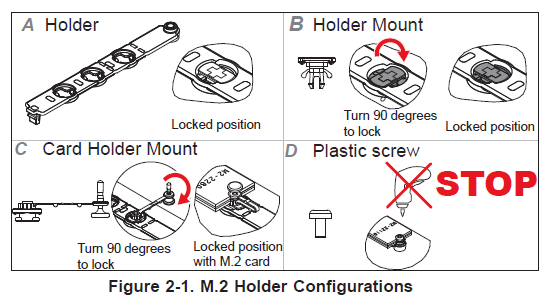
- Determine the appropriate installation location on the M.2 holder, based on the M.2 device length.
- Slot M.2 device into M.2 connector and lay flat on M.2 holder (Figure 2-1, Section A).
- Secure the M.2 device using the plastic screw. Do not over-torque the screw (Figure 2- 1, Section D).Note: Follow steps 4-6 for M.2 devices that are shorter than full-length.
- Install a card holder mount into the appropriate mounting position on the M.2 holder (Figure 2-1, Section C). Turn 90 degrees to lock the mount into position.
- Slot M.2 device into M.2 connector and lay flat on M.2 holder (Figure 2-1, Section A).
- Push the pin end of the card holder mount into the pin receptacle on the card holder mount. The pin will snap into position when pushed enough (Figure 2-1, Section C).
Rear I/O Ports
Refer to Figure 2-2 below for the locations and descriptions of the various I/O ports on the rear of the motherboard. 
|
Rear I/O Ports |
|||||||
|
# |
Description |
# |
Description |
# |
Description |
# |
Description |
|
1 |
DisplayPort |
6 |
LAN1 |
11 |
USB2 (USB 3.1 Gen 1) |
16 |
Line Out |
|
2 |
HDMI |
7 |
USB7 (USB 3.1 Gen 2 Type-A) |
12 |
Center/LFE Out |
17 |
Mic In |
|
3 |
WiFi + BT (X11SCA-W only) |
8 |
USB6 (USB 3.1 Gen 2 Type-C) |
13 |
Surround Out |
||
|
4 |
VGA (X11SCA-F only) |
9 |
LAN2 |
14 |
SPDIF Out |
||
|
5 |
DVI |
10 |
USB3 (USB3.1 Gen 1) |
15 |
Line In |
VGA/DVI Ports (X11SCA-F only)
The VGA and DVI ports are located on the left of LAN1 on the I/O back panel. Refer to the layout below for the locations.
COM Port Header
One COM connection (COM1) is located on the motherboard. Refer to the table below for pin definitions.
|
COM Port Header Pin Definitions |
|||
|
Pin# |
Definition |
Pin# |
Definition |
|
1 |
DCD |
6 |
DSR |
|
2 |
RXD |
7 |
RTS |
|
3 |
TXD |
8 |
CTS |
|
4 |
DTR |
9 |
RI |
|
5 |
Ground |
10 |
N/A |
VGA/DVI Ports
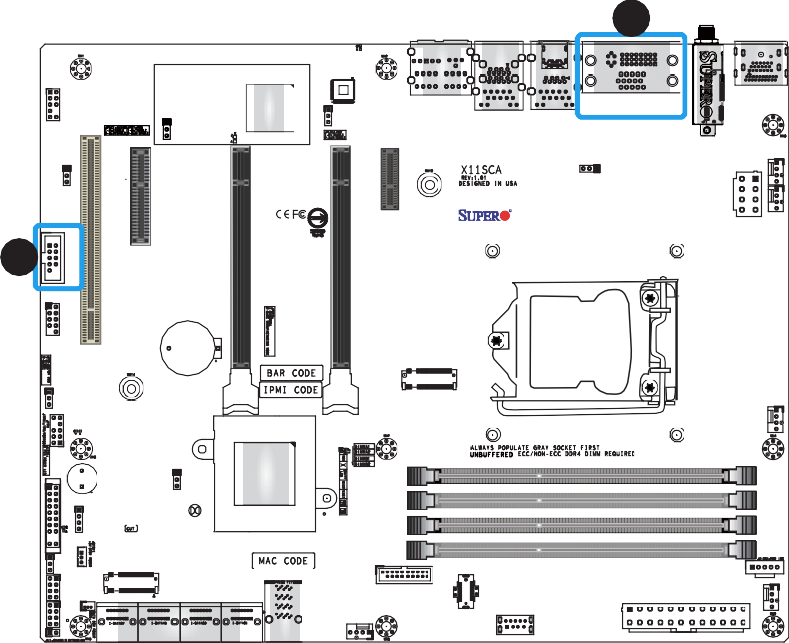
Universal Serial Bus (USB) Ports
There are two USB 3.1 Gen 1 ports (USB2/3) and two USB 3.1 Gen 2 ports (USB6/7) located on the I/O back panel. The motherboard also has two front access USB headers (USB0/1: USB 2.0, USB4/5: USB 3.1 Gen 1) and two front access USB 3.1 headers (USB8 and USB9). The USB8 header supports Type-C and USB9 supports Type-A. The onboard headers can be used to provide front side USB access with a cable (not included).
Note: USB wake up capabilities are limited to the USB0/1 header and USB7 port. USB wake up is enabled by default in the BIOS. Disabling this feature must be completed in the operating system.
|
Type-A USB9 (3.1 Gen 1) Pin Definitions |
|||
|
Pin# |
Definition |
Pin# |
Definition |
|
1 |
VBUS |
5 |
SSRX- |
|
2 |
USB_N |
6 |
SSRX+ |
|
3 |
USB_P |
7 |
GND |
|
4 |
Ground |
8 |
SSTX- |
|
9 |
SSTX+ |
|
Front Panel USB 0/1 (2.0) Pin Definitions |
|||
|
Pin# |
Definition |
Pin# |
Definition |
|
1 |
+5V |
2 |
+5V |
|
3 |
USB_N |
4 |
USB_N |
|
5 |
USB_P |
6 |
USB_P |
|
7 |
Ground |
8 |
Ground |
|
9 |
Key |
10 |
NC |
|
Back Panel USB 2/3 (3.1 Gen 1) Pin Definitions |
|||
|
Pin# |
Definition |
Pin# |
Definition |
|
A1 |
VBUS |
B1 |
Power |
|
A2 |
D- |
B2 |
USB_N |
|
A3 |
D+ |
B3 |
USB_P |
|
A4 |
GND |
B4 |
GND |
|
A5 |
Stda_SSRX- |
B5 |
USB3_RN |
|
A6 |
Stda_SSRX+ |
B6 |
USB3_RP |
|
A7 |
GND |
B7 |
GND |
|
A8 |
Stda_SSTX- |
B8 |
USB3_TN |
|
A9 |
Stda_SSTX+ |
B9 |
USB3_TP |
USB
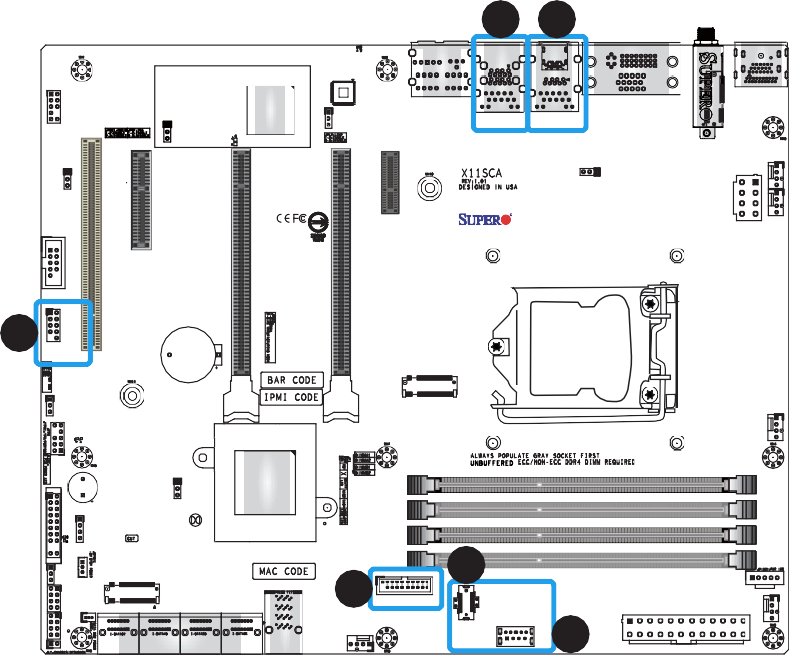
LAN Ports
Two Gigabit Ethernet ports (LAN1 and LAN2) are located on the I/O back panel of the motherboard. All of these ports accept RJ45 cables. Please refer to the Section 2.10 LED Indicators for LAN LED information.
|
LAN Port Pin Definitions |
|||
|
Pin# |
Definition |
Pin# |
Definition |
|
1 |
TX_D1+ |
5 |
BI_D3- |
|
2 |
TX_D1- |
6 |
RX_D2- |
|
3 |
RX_D2+ |
7 |
BI_D4+ |
|
4 |
BI_D3+ |
8 |
BI_D4- |
Front Control Panel
JF1 contains header pins for various buttons and indicators that are normally located on a control panel at the front of the chassis. These connectors are designed specifically for use with Supermicro chassis. Refer to the figure below for the descriptions of the front control panel buttons and LED indicators
Figure 2-3. JF1 Header Pins
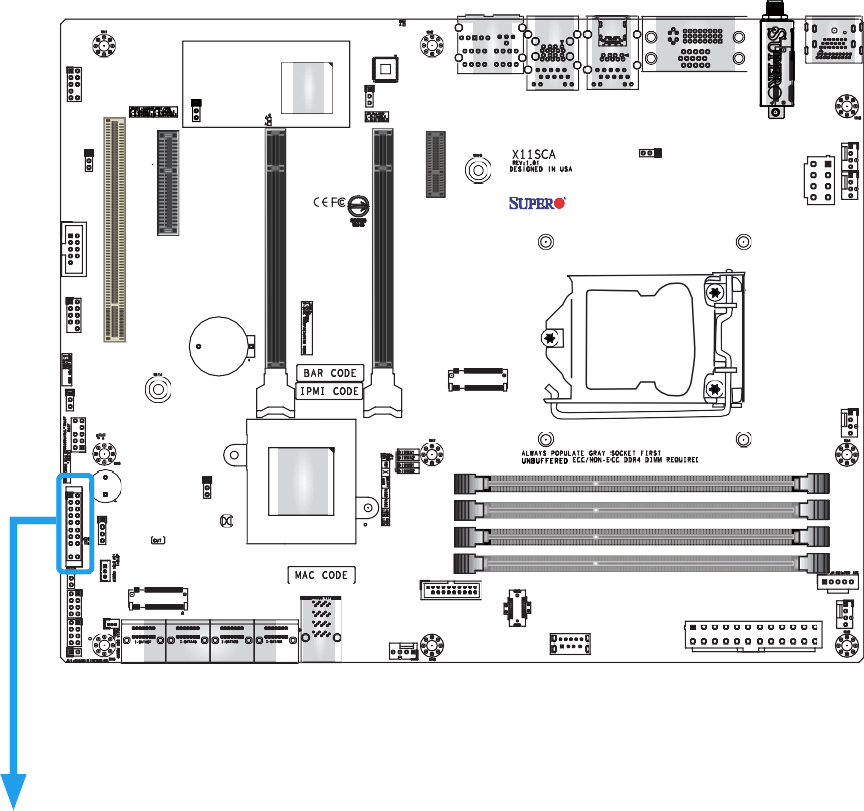
The Power Button connection is located on pins 1 and 2 of JF1. Momentarily contacting both pins will power on/off the system. This button can also be configured to function as a suspend button (refer to Chapter 4). To turn off the power when the system is in suspend mode, press the button for four seconds or longer. Refer to the table below for pin definitions.
|
Power Button Pin Definitions (JF1) |
|
|
Pin# Definition |
|
|
1 |
Signal |
|
2 |
Ground |
The Reset Button connection is located on pins 3 and 4 of JF1. Attach it to a hardware reset switch on the computer case. Refer to the table below for pin definitions.
|
Reset Button Pin Definitions (JF1) |
|
|
Pin# Definition |
|
|
3 |
Reset |
|
4 |
Ground |
NIC1/NIC2 (LAN1/LAN2)
The NIC (Network Interface Controller) LED connection for LAN port 1 is located on pins 11 and 12 of JF1, and the LED connection for LAN port 2 is on pins 9 and 10. Attach the NIC LED cables here to display network activity. Refer to the table below for pin definitions.
|
LAN1/LAN2 LED Pin Definitions (JF1) |
|
|
Pin# Definition |
|
|
9 |
Pull up to +3.3 Stby |
|
10 |
NIC2 Activity LED |
|
11 |
Pull up to +3.3 Stby |
|
12 |
NIC1 Activity LED |
HDD LED/UID Switch
The HDD LED connection is located on pins 13 and 14 of JF1. Attach a cable to pin 14 to show hard drive activity status. Attach a cable to pin 13 to use UID switch. Refer to the table below for pin definitions.
|
HDD LED Pin Definitions (JF1) |
|
|
Pin# Definition |
|
|
13 |
3.3V Stdby |
|
14 |
HDD Active |
Power LED
The Power LED connection is located on pins 15 and 16 of JF1. Refer to the table below for pin definitions.
|
Power LED Pin Definitions (JF1) |
|
|
Pin# Definition |
|
|
15 |
3.3V |
|
16 |
PWR LED |
The non-maskable interrupt button header is located on pins 19 and 20 of JF1. Refer to the table below for pin definitions.
|
NMI Button Pin Definitions (JF1) |
|
|
Pin# Definition |
|
|
19 |
Control |
|
20 |
Ground |
Connectors
Main ATX Power Supply Connector
The primary power supply connector (JPW1) meets the ATX SSI EPS 12V specification. You must also connect the 8-pin (JPW2) processor power connector to your power supply.
|
ATX Power 24-pin Connector Pin Definitions |
|||
|
Pin# |
Definition |
Pin# |
Definition |
|
13 |
+3.3V |
1 |
+3.3V |
|
14 |
-12V |
2 |
+3.3V |
|
15 |
Ground |
3 |
Ground |
|
16 |
PS_ON |
4 |
+5V |
|
17 |
Ground |
5 |
Ground |
|
18 |
Ground |
6 |
+5V |
|
19 |
Ground |
7 |
Ground |
|
20 |
Res (NC) |
8 |
PWR_OK |
|
21 |
+5V |
9 |
5VSB |
|
22 |
+5V |
10 |
+12V |
|
23 |
+5V |
11 |
+12V |
|
24 |
Ground |
12 |
+3.3V |
Required Connection

Secondary Power Connector
JPW2 must also be connected to the power supply. This connector is used to power the processor.
|
+12V 8-pin Power Connector Pin Definitions |
|
|
Pin# |
Definition |
|
1-4 |
Ground |
|
5-8 |
+12V |
Required Connection
Important: To provide adequate power supply to the motherboard, be sure to connect the 24-pin ATX PWR and the 8-pin PWR connectors to the power supply. Failure to do so may void the manufacturer warranty on your power supply and motherboard.
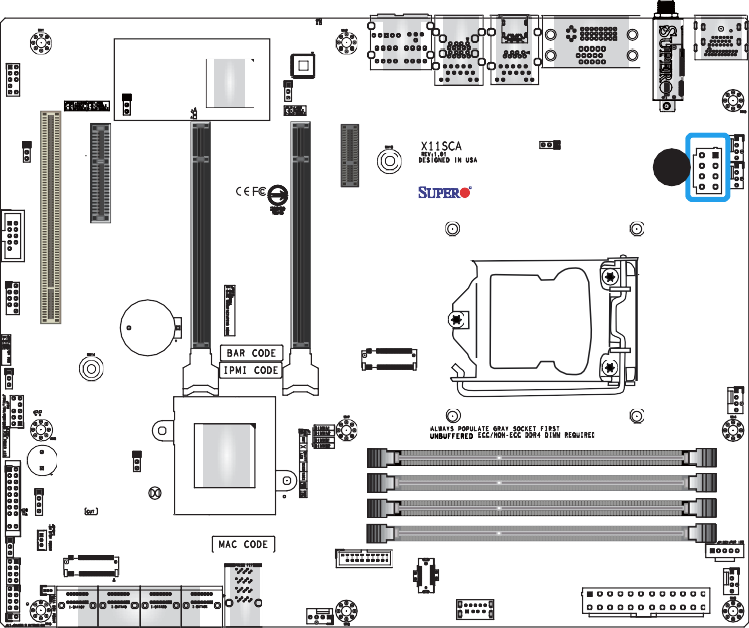
Fan Headers
The X11SCA/-W/-F has five fan headers (CPU_FAN1 ~ FAN2, SYS_FAN1 ~ FAN3). All of these 4-pin fan headers are backwards compatible with the traditional 3-pin fans. However, fan speed control is only available for 4-pin fans by Thermal Management via the IPMI 2.0 interface. Refer to the table below for pin definitions.
|
Fan Header Pin Definitions |
|
|
Pin# |
Definition |
|
1 |
Ground (Black) |
|
2 |
2.5A/+12V (Red) |
|
3 |
Tachometer |
|
4 |
PWM_Control |
Speaker/Buzzer Header
On the SPKR header, pins 1-4 are for the speaker and pins 3-4 are for the buzzer. If you wish to use an external speaker, connect its cable to pins 1-4.
|
Speaker Header Pin Definitions |
|
|
Pin Setting |
Definition |
|
Pins 1-4 |
Speaker |
|
Pins 3-4 |
Buzzer |
CPU_FAN1

Troubleshooting
Troubleshooting Procedures
Use the following procedures to troubleshoot your system. If you have followed all of the procedures below and still need assistance, refer to the ‘Technical Support Procedures’ and/ or ‘Returning Merchandise for Service’ section(s) in this chapter. Always disconnect the AC power cord before adding, changing or installing any non hot-swap hardware components.
Before Power On
- Make sure that there are no short circuits between the motherboard and chassis.
- Disconnect all ribbon/wire cables from the motherboard, including those for the keyboard and mouse.
- Remove all add-on cards.
- Install the CPU (making sure it is fully seated) and connect the front panel connectors to the motherboard.
No Power
- Make sure that there are no short circuits between the motherboard and the chassis.
- Make sure that the ATX power connectors are properly connected.
- Check that the 115V/230V switch, if available, on the power supply is properly set.
- Turn the power switch on and off to test the system, if applicable.
- The battery on your motherboard may be old. Check to verify that it still supplies ~3VDC. If it does not, replace it with a new one.
No Video
- If the power is on but you have no video, remove all add-on cards and cables.
- Use the speaker to determine if any beep codes are present. Refer to Appendix A for details on beep codes.
- Remove all memory modules and turn on the system (if the alarm is on, check the specs of memory modules, reset the memory or try a different one).
System Boot Failure
If the system does not display POST or does not respond after the power is turned on, check the following:
- Check for any error beep from the motherboard speaker.
- If there is no error beep, try to turn on the system without DIMM modules installed. If there is still no error beep, replace the motherboard.
- If there are error beeps, clear the CMOS settings by unplugging the power cord and con- tacting both pads on the CMOS clear jumper (JBT1). (Refer to Section 2.9 in Chapter 2.)
- Remove all components from the motherboard, especially the DIMM modules. Make sure that system power is on and that memory error beeps are activated.
- Turn on the system with only one DIMM module installed. If the system boots, check for bad DIMM modules or slots by following the Memory Errors Troubleshooting procedure in this chapter.
Memory Errors
When a no-memory beep code is issued by the system, check the following:
- Make sure that the memory modules are compatible with the system and that the DIMMs are properly and fully installed. (For memory compatibility, refer to the memory compatibility chart posted on our website at http://www.supermicro.com.)
- Check if different speeds of DIMMs have been installed. It is strongly recommended that you use the same RAM type and speed for all DIMMs in the system.
- Make sure that you are using the correct type of ECC DDR4 UDIMM modules recommended by the manufacturer.
- Check for bad DIMM modules or slots by swapping a single module among all memory slots and check the results.
- Make sure that all memory modules are fully seated in their slots. Follow the instructions given in Section 2.4 in Chapter 2.
- Please follow the instructions given in the DIMM population tables listed in Section 2.4 to install your memory modules.
Losing the System’s Setup Configuration
- Make sure that you are using a high-quality power supply. A poor-quality power supply may cause the system to lose the CMOS setup information. Refer to Section 2.8 for details on recommended power supplies.
- The battery on your motherboard may be old. Check to verify that it still supplies
~3VDC. If it does not, replace it with a new one. If the above steps do not fix the setup configuration problem, contact your vendor for repairs.
When the System Becomes Unstable
- If the system becomes unstable during or after OS installation, check the following:
- CPU/BIOS support: Make sure that your CPU is supported and that you have the latest BIOS installed in your system.
- Memory support: Make sure that the memory modules are supported by testing the modules using memtest86 or a similar utility.Note: Refer to the product page on our website at http://www.supermicro.com for memory and CPU support and updates.
- HDD support: Make sure that all hard disk drives (HDDs) work properly. Replace the bad HDDs with good ones.
- System cooling: Check the system cooling to make sure that all heatsink fans and CPU/ system fans, etc., work properly. Check the hardware monitoring settings in the IPMI to make sure that the CPU and system temperatures are within the normal range. Also check the front panel Overheat LED and make sure that it is not on.
- Adequate power supply: Make sure that the power supply provides adequate power to the system. Make sure that all power connectors are connected. Please refer to our website for more information on the minimum power requirements.
- Proper software support: Make sure that the correct drivers are used.
- If the system becomes unstable before or during OS installation, check the following:
- Source of installation: Make sure that the devices used for installation are working properly, including boot devices such as CD/DVD.
- Cable connection: Check to make sure that all cables are connected and working properly.
- Using the minimum configuration for troubleshooting: Remove all unnecessary components (starting with add-on cards first), and use the minimum configuration (but with the CPU and a memory module installed) to identify the trouble areas. Refer to the steps listed in Section A above for proper troubleshooting procedures.
- Identifying bad components by isolating them: If necessary, remove a component in question from the chassis, and test it in isolation to make sure that it works properly. Replace a bad component with a good one.
- Check and change one component at a time instead of changing several items at the same time. This will help isolate and identify the problem.
- To find out if a component is good, swap this component with a new one to see if the system will work properly. If so, then the old component is bad. You can also install the component in question in another system. If the new system works, the component is good and the old system has problems.
Technical Support Procedures
Before contacting Technical Support, please take the following steps. Also, please note that as a motherboard manufacturer, Supermicro also sells motherboards through its channels, so it is best to first check with your distributor or reseller for troubleshooting services. They should know of any possible problems with the specific system configuration that was sold to you.
- Please go through the Troubleshooting Procedures and Frequently Asked Questions (FAQ) sections in this chapter or see the FAQs on our website (http://www.supermicro. com/) before contacting Technical Support.
- BIOS upgrades can be downloaded from our website http://www.supermicro.com/ ResourceApps/BIOS_IPMI_Intel.html.
- If you still cannot resolve the problem, include the following information when contacting Supermicro for technical support:
- Motherboard model and PCB revision number
- BIOS release date/version (This can be seen on the initial display when your system first boots up.)
- System configuration
- An example of a Technical Support form is on our website at http://www.supermicro.com/ RmaForm/
- Distributors: For immediate assistance, please have your account number ready when placing a call to our Technical Support department. We can be reached by email at sup- [email protected].
Frequently Asked Questions
Question: What type of memory does my motherboard support?
Answer: The motherboard supports ECC DDR4 UDIMM modules. To enhance memory performance, do not mix memory modules of different speeds and sizes. Please follow all memory installation instructions given in Section 2.4 Memory Support and Installation.
Question: How do I update my BIOS?
Answer: It is recommended that you do not upgrade your BIOS if you are not experiencing any problems with your system. Updated BIOS files are located on our website at http://www.supermicro.com/ResourceApps/BIOS_IPMI_Intel.html. Please check our BIOS warning message and the information on how to update your BIOS on our website. Select your motherboard model and download the BIOS file to your computer. Also, check the current BIOS revision to make sure that it is newer than your BIOS before downloading. To update your BIOS under the UEFI shell, please unzip the BIOS file onto a USB device formatted with the FAT/FAT32 file system. When the UEFI shell prompt appears, type fs# to change the device directory path. Go to the directory that contains the BIOS package you extracted earlier. Enter flash.nsh BIOSname#.### at the prompt to start the BIOS update process. Reboot the system when you see the message that BIOS update has completed. Refer to the readme file for more information.
Warning: Do not shut down or reset the system while updating the BIOS to prevent pos- sible system boot failure!
Note: The SPI BIOS chip used on this motherboard cannot be removed. Send your motherboard back to our RMA Department at Supermicro for repair. For BIOS Recov- ery instructions, please refer to the AMI BIOS Recovery Instructions posted at http:// www.supermicro.com

|
LAN1/2 Activity LEDs (Right) LED State |
||
|
Color |
Status |
Definition |
|
Green |
Flashing |
Active |
|
LAN1/2 Link LEDs (Left) LED State |
||
|
LED Color |
Definition |
|
|
Off |
No Connection |
|
|
Amber |
10 Mbps/100 Mbps |
|
|
Green |
1 Gbps |
Battery Removal and Installation
Battery Removal
To remove the onboard battery, follow the steps below:
- Power off your system and unplug your power cable.
- Locate the onboard battery as shown below.
- Using a tool such as a pen or a small screwdriver, push the battery lock outwards to unlock it. Once unlocked, the battery will pop out from the holder.
- Remove the battery.
Proper Battery Disposal
Please handle used batteries carefully. Do not damage the battery in any way; a damaged battery may release hazardous materials into the environment. Do not discard a used battery in the garbage or a public landfill. Please comply with the regulations set up by your local hazardous waste management agency to dispose of your used battery properly.
Battery Installation
- To install an onboard battery, follow the steps 1 and 2 above and continue below:
- Identify the battery’s polarity. The positive (+) side should be facing up.
- Insert the battery into the battery holder and push it down until you hear a click to ensure that the battery is securely locked.
Important: When replacing a battery, be sure to only replace it with the same type.
Returning Merchandise for Service
A receipt or copy of your invoice marked with the date of purchase is required before any warranty service will be rendered. You can obtain service by calling your vendor for a Returned Merchandise Authorization (RMA) number. When returning to the manufacturer, the RMA number should be prominently displayed on the outside of the shipping carton and mailed prepaid or hand-carried. Shipping and handling charges will be applied for all orders that must be mailed when service is complete.
For faster service, RMA authorizations may be requested online http://www.supermicro.com/support/rma/
This warranty only covers normal consumer use and does not cover damages incurred in shipping or from failure due to the alteration, misuse, abuse or improper maintenance of products.
During the warranty period, contact your distributor first for any product problems.
UEFI BIOS
Introduction
This chapter describes the AMIBIOS™ Setup utility for the X11SCA/-W/-F motherboard. The BIOS is stored on a chip and can be easily upgraded using a flash program.
Note: Due to periodic changes to the BIOS, some settings may have been added or deleted and might not yet be recorded in this manual. Please refer to the Manual Download area of our website for any changes to the BIOS that may not be reflected in this manual.
Starting the Setup Utility
To enter the BIOS Setup Utility, hit the <Delete> key while the system is booting up. (In most cases, the <Delete> key is used to invoke the BIOS setup screen. There are a few cases when other keys are used, such as <F1>, <F2>, etc.) Each main BIOS menu option is described in this manual.
The Main BIOS screen has three main frames. The upper frame displays the time and date, as well as motherboard information (model, BIOS data, CPU data, and memory data). The left frame displays all the features that can be configured. “Grayed-out” features cannot be configured. The right frame displays the key legend. Above the key legend is an area reserved for a text message. When an option is selected in the left frame, it is highlighted in blue. Often a text message will accompany it. (Note that BIOS has default text messages built in. We retain the option to include, omit, or change any of these text messages.) Settings printed in Bold are the default values.
A “►” indicates a submenu. Highlighting such an item and pressing the <Enter> key will open the list of settings within that submenu.
The BIOS Setup utility uses a key-based navigation system called hot keys. Most of these hot keys (<F1>, <F2>, <F3>, <Enter>, <ESC>, <Arrow> keys, etc.) can be used at any time during the setup navigation process.
Main
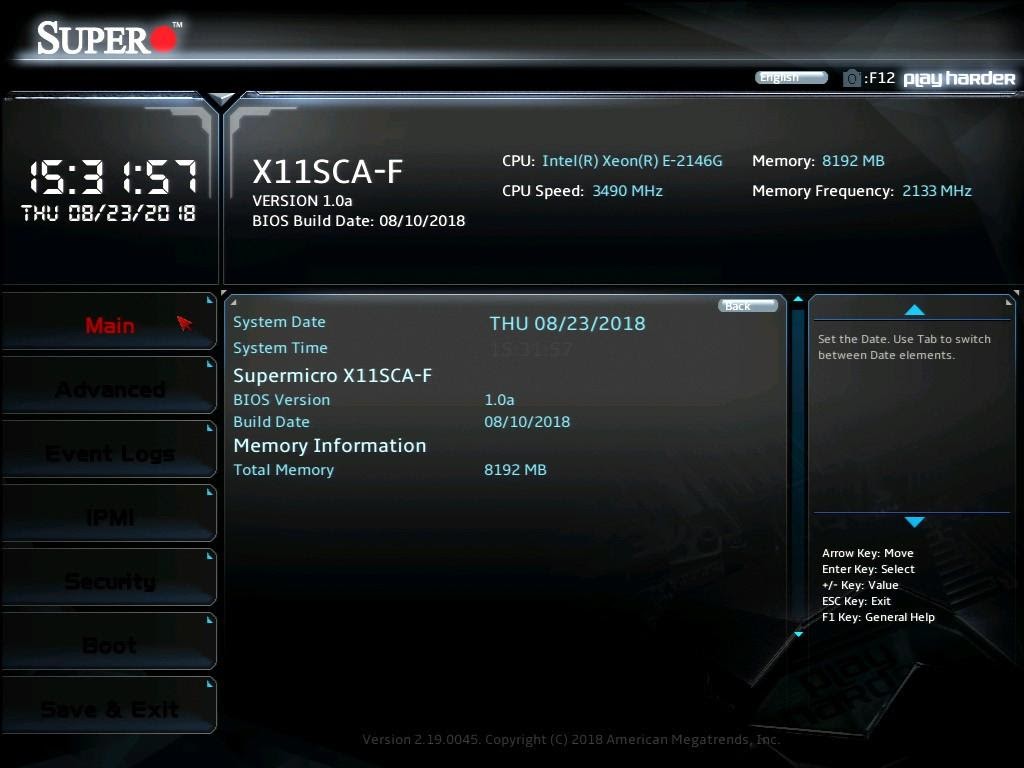
The following information is displayed in this section:
- System Date – the date the system is set to
- System Time – the time the system is set to
- Motherboard Model – the model of the motherboard
- BIOS Version – the current BIOS version
- Build Date – the date the BIOS version was released
- Total Memory – the total memory installed on the system
Advanced
Warning: Take caution when changing the Advanced settings. An incorrect value, a very high frequency, or an incorrect timing setting may make the system unstable. If this oc- curs, revert to the default to the manufacture default settings.
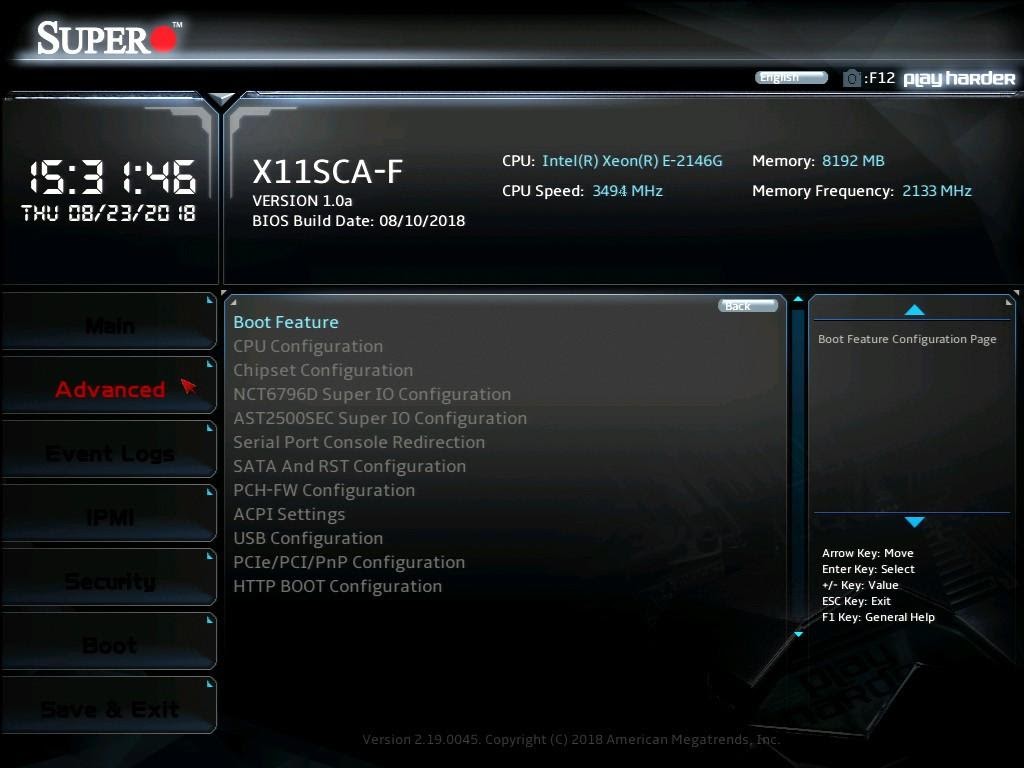
Boot Feature
Fast Boot
This feature enables the system to boot with a minimal set of required devices to launch. This has no effect on BBS boot options. The options are Disabled and Enabled.
Quiet Boot
Use this feature to select the screen display between the POST messages and the OEM logo upon bootup. Uncheck the box to display the POST messages. Check the box to display the OEM logo instead of the normal POST messages. The default is Checked.
Bootup NumLock State
Use this feature to set the Power-on state for the <Numlock> key. The options are On and Off.
Option ROM Messages
This feature controls the display mode for Option ROM. The options are Force BIOS and Keep Current.
Wait For “F1” If Error
Use this feature to force the system to wait until the “F1” key is pressed if an error occurs. The options are Disabled and Enabled.
Re-try Boot
If this feature is enabled, the BIOS will automatically reboot the system from a specified boot device after its initial boot failure. The options are Disabled, Legacy Boot, and EFI Boot.
Watch Dog Function
If enabled, the Watch Dog Timer will allow the system to reset or generate NMI based on jumper settings when it is expired for more than five minutes. The options are Disabled and Enabled.
AC Loss Policy Depend on
Use this feature to set the power state after a power outage. Select Stay Off for the system power to remain off after a power loss. Select Power On for the system power to be turned on after a power loss. Select Last State to allow the system to resume its last power state before a power loss. The options are Stay Off, Power On, and Last State.
This feature controls how the system shuts down when the power button is pressed. Select 4 Seconds Override for the user to power off the system after pressing and holding the power button for four seconds or longer. Select Instant Off to instantly power off the system as soon as the user presses the power button. The options are Instant Off and 4 Seconds Override.
DeepSx Power Policies
Use this feature to configure the Advanced Configuration and Power Interface (ACPI) settings for the system. Enable S5 to power off the whole system except the power supply unit (PSU) and keep the power button alive so that the user can wake up the system by using an USB keyboard or mouse. The options are Disabled and Enabled in S4-S5.
Install Windows 7 USB Support
Enable this feature to use the USB keyboard and mouse during the Windows 7 installation, since the native XHCI driver support is unavailable. Use a SATA optical drive as a USB drive, and USB CD/DVD drives are not supported. Disable this feature after the XHCI driver has been installed in Windows. The options are Disabled and Enabled.
CPU Configuration
The following information is displayed in this section:
- CPU Signature – the processor identification code
- Microcode Patch – the microcode revision number
- MAX CPU Speed – the maximum CPU speed
- Min CPU Speed – the minimum CPU speed
- CPU Speed – the approximate CPU speed
- Processor Cores – the number of processor cores
- Hyper Threading Technology – displays whether hyper threading is supported
- VMX – displays whether VMX is supported
- SMX/TXT – displays whether SMX/TXT is supported
- 64-bit – displays whether 64-bit technology is supported
- EIST Technology – displays whether EIST technology is supported
- CPU C3 state – displays whether CPU C3 is supported
- CPU C6 state – displays whether CPU C6 is supported
- CPU C7 state – displays whether CPU C7 is supported
- CPU C8 state – displays whether CPU C8 is supported
- CPU C9 state – displays whether CPU C9 is supported
- CPU C10 state – displays whether CPU C10 is supported
- L1 Data Cache – the size of the L1 data cache (if supported)
- L1 Instruction Cache – the size of the L1 instruction cache (if supported)
- L2 Cache – the size of the L2 cache (if supported)
- L3 Cache – the size of the L3 cache (if supported)
- L4 Cache – the size of the L4 cache (if supported)
C6DRAM
This feature enables moving DRAM contents to PRM memory when the CPU is in a C6 state. The options are Disabled and Enabled.
Hardware Prefetcher
If set to Enabled, the hardware prefetcher will prefetch streams of data and instructions from the main memory to the L2 cache to improve CPU performance. The options are Disabled and Enabled.
Adjacent Cache Line Prefetch
Select Enabled for the CPU to prefetch both cache lines for 128 bytes as comprised. Select Disabled for the CPU to prefetch both cache lines for 64 bytes. The options are Disabled and Enabled.
Intel (VMX) Virtualization Technology
Select Enabled to use the Intel Virtualization Technology to allow one platform to run multiple operating systems and applications in independent partitions, creating multiple “virtual” systems in one physical computer. The options are Disabled and Enabled.
Note: If there is any change to this setting, you will need to power off and reboot the system for the change to take effect. Please refer to Intel’s website for detailed information.
Active Processor Cores
Use this feature to select the number of active processor cores. The options depend on how many cores are supported by the CPU (up to 8). The default is All.
Hyper-Threading
This feature should be enabled for Windows XP and Linux. This feature should be disabled for other operating systems, as they are not optimized for Hyper-Threading. The default is Enabled.
AES
This feature enables Intel CPU Advanced Encryption Standard (AES) Instructions support to enhance data integrity. The options are Disabled and Enabled.
Boot Performance Mode
This feature enables the selection of the default CPU performance during system boot. The options are Max Non-Turbo Performance, Power Saving, and Turbo Performance.
Intel(R) SpeedStep(tm)
Intel SpeedStep Technology allows the system to automatically adjust processor voltage and core frequency in an effort to reduce power consumption and heat dissipation. Please refer to Intel’s website for detailed information. The options are Disabled and Enabled.
Intel(R) Speed Shift Technology
This feature enables Intel® Speed Shift Technology support, which exposes the CPPC v2 interface to allow for hardware controlled P-States. The options are Disabled and Enabled.
Turbo Mode
This feature enables Turbo Mode if EMTTM is also enabled. The options are Disabled and
Enabled.
Package Power Limit MSR Lock
This feature enables Package Power Limit locking. If this is enabled, a reset will be required to unlock the register. The options are Disabled and Enabled.
Power Limit 1 Override
This feature enables Power Limit 1 override. When this is disabled, the BIOS will use default values. The default is Disabled.
Power Limit 2 Override
This feature enables Power Limit 2 override. When this is disabled, the BIOS will use default values. The default is Enabled.
Power Limit 2
Enter a value for Power Limit 2. The default is 0.
- core ~ 6-core Ratio Limit Override
The number of cores available to modify depends on the CPU installed. Enter a ratio limit value for individual cores.
C states
C-State architecture, a processor power management platform developed by Intel, can further reduce power consumption from the basic C1 (Halt State) state that blocks clock cycles to the CPU. Select Enabled for CPU C-State support. The options are Disabled and Enabled. If this feature is set to Enabled, the following features will display:
Enhanced C-states
This feature enables Enhanced C1 Power State to boost system performance. The options are Disabled and Enabled.
C-State Auto Demotion
When this feature is enabled, the CPU will conditionally demote C State based on un-cored auto-demote information. The options are Disabled, C1, C3, and C1 and C3.
C-State Un-demotion
When this feature is enabled, the CPU will conditionally undemote from demoted C1 or C3. The options are Disabled, C1, C3, and C1 and C3.
Package C-State Demotion
This feature enables the Package C-State demotion. The options are Disabled and Enabled.
Package C-State Un-demotion
When this feature is enabled, the CPU will conditionally undemote from demoted Packaged Package C-State Un-Demotion. The options are Disabled and Enabled.
CState Pre-Wake
Use this feature to enable the C-State pre wake. The options are Disabled and Enabled.
Package C State Limit
Select Auto for the AMI BIOS to automatically set the limit on the C-State package register. The options are C0/C1, C2, C3, C6, C7, C7s, C8, C9, C10, CPU Default, and Auto.
Chipset Configuration
System Agent (SA) Configuration
- SA PCIe Code Version
- VT-d
- Memory Configuration
The following information is displayed:
- Memory RC Version
- Memory Frequency
- Memory Timings (tCL-tRCD-tRP-tRAS)
- DIMMA1 ~ DIMMB2 information
Maximum Memory Frequency
This feature selects the type/speed of the memory installed. The options are Auto, 1067, 1333, 1400, 1600, 1867, 2133, 2200, 2400, 2600, and 2667. All values are in MHz.
Max TOLUD
This feature sets the maximum TOLUD value, which specifies the “Top of Low Usable DRAM” memory space to be used by internal graphics devices, GTT Stolen Memory, and TSEG, respectively, if these devices are enabled. The options are Dynamic, 1 GB
~ 3.5 GB (in increments of 0.25 GB).
This feature enables memory scrambler support for memory error correction. The options are Disabled and Enabled.
Use this feature to enable or disable fast path through the memory reference code. The options are Disabled and Enabled.
- Graphics Configuration
- IGFX VBIOS Version
- IGFX GOP Version
Primary Display
This feature controls which graphics device will be used as the primary display. The op- tions are Auto, IGFX, PEG, PCI, and SG.
Primary PEG
This feature controls the graphics device to be used as the primary device. The options are CPU SLOT6 PCI-E 3.0 X16 and CPU SLOT4 PCI-E 3.0 X8 (IN X16).
Primary PCIE
This feature controls the primary PCIE device. The options are Auto, OnBoard, PCH SLOT2 PCI-E 3.0 X4, and PCH SLOT7 PCI-E 3.0 X1.
Internal Graphics
This feature enables internal graphics support, based on the setup options. The options are Auto, Disabled, and Enabled.
GTT Size
This feature controls the memory allocation size for the graphics translation table (GTT).
The options are 2MB, 4MB, and 8MB.
This feature controls the graphics aperture size. For optimal performance, select the size that matches the installed graphics card’s size. The options are 128MB, 256MB, 512MB, 1024MB, and 2048MB.
This feature controls the DVMT 5.0 Pre-allocated graphics memory size to be used by the internal grahics device. The options are 0M, 32M, 64M, 4M, 8M, 12M, 16M, 20M, 24M, 28M, 36M, 40M, 44M, 48M, 52M, 56M, and 60M.
This feature controls the DVMT 5.0 total graphics size to be used by the internal graphics device. The options are 128M, 256M, and MAX.
This feature enables VDD in the BIOS. The options are Disabled and Enabled.
Enable this feature to activate Power Management BIOS support. The options are En- able and Disable.
Protected Audio Video Path (PAVP) decodes Intel integrated graphics encrypted video. The options are Enable and Disable.
This feature enables Cdynmax Clamping. The options are Enable and Disable.
This feature controls the graphics clock frequency. Select the highest clock frequency supported by the platform. The options are 337.5 MHz, 450 MHz, 540 MHz, and 675 MHz.
When this feature is enabled, the system will skip full CD clock initialization during S3 Resume. The options are Enable and Disable.
DMI/OPI Configuration
This feature displays the DMI link and speed information.
This feature enables the control of Active State Power Management (ASPM) on the SA side of the DMI Link. The options are Disabled and L0sL1.
This feature enables DMI Extended Synchronization support. The options are Disabled
and Enabled.
This feature controls the DMI De-emphasis setting. The options are -6 dB and -3.5 dB.
PEG Port Configuration
This displays information if a PCI-E device is installed.
Select Auto, Gen1, Gen2, or Gen3 to set the PEG Max Link Speed.
Enter a value for the upper limit on power (in watts) supplied by the slot. The range is 0-255. The default is 75.
This feature controls the slot power limit scale. The options are 1.0x, 0.1x, 0.01x, and 0.001x.
This displays information if a PCI-E device is installed.
Select Auto, Gen1, Gen2, or Gen3 to set the PEG Max Link Speed.
Enter a value for the upper limit on power (in watts) supplied by the slot. The range is 0-255. The default is 75.
This feature controls the slot power limit scale. The options are 1.0x, 0.1x, 0.01x, and 0.001x.
Use this feature to activate the Active State Power Management (ASPM) level for a PCI- E device. Select Auto for the system BIOS to automatically set the ASPM level based on the system configuration. Select Disabled to disable ASPM support. The options are Disable, Auto, ASPM L0s, ASPM L1, and ASPM L0sL1.
This feature enables PCIe ASPM programming after OpROM. If set to Disabled, program- ming occurs before OpROM. The options are Disabled and Enabled.
GT – Power Management Control
Use this feature to enable Render Standby support. The options are Disabled and En- abled.
This feature defines the Maximum GT Frequency. Choose between 300MHz (RPN) and 1200MHz (RP0). Any value beyond this range will be clipped to its min/max supported by the CPU. The options are Default Max Frequency and 300MHz~1200MHz (in incre- ments of 50MHz).
This feature disables Turbo GT frequency. Selecting Enabled disables Turbo GT fre- quency. If set to Disabled, GT frequency limiters will be removed. The default is Disabled.
Select Enabled to activate Intel Virtualization Technology support for Direct I/O VT-d by reporting the I/O device assignments to VMM through the DMAR ACPI Tables. This feature offers fully-protected I/O resource-sharing across the Intel platforms, providing the user with greater reliability, security and availability in networking and data-sharing. The options are Disable and Enable.
Select Enabled to activate the Software Guard Extensions (SGX). The options are Disabled, Enabled, and Software Controlled.
There are three Owner EPOCH modes (each EPOCH is 64 bit). The options are No Change in Owner EPOCHs, Change to New Random Owner EPOCH, and Manual User Defined Owner EPOCHs.
This feature enables the SA GNA device. The options are Disabled and Enabled.
This feature enables X2APIC Opt Out. The options are Disabled and Enabled.
PCH-IO Configuration
-
PCH SKU
- Stepping
- PCI Express Configuration
DMI Link ASPM Control
This feature enables the control of Active State Power Management (ASPM) on the SA side of the DMI Link. The options are Disabled, L0s, L1, L0sL1, and Auto.
This feature enables Peer Memory Writing. The options are Disabled and Enabled.
PCH SLOT7 PCI-E 3.0 X1
This feature controls the Active State Power Management (ASPM) setting. The options are Disabled, L0s, L1, L0sL1, and Auto.
This feature controls L1 Substates. The options are Disabled, L1.1, and L1.1 & L1.2.
This feature enables Precision Time Measurement (PTM). The options are Disabled and Enabled.
This feature enables Downstream Port Containment (DPC). The options are Disabled and Enabled.
This feature enables rootport Extension for Downstream Port Containment. The options are Disabled and Enabled.
This feature controls the PCIe Speed. The options are Auto, Gen1, Gen2, and Gen3.
PCI-E M.2-M2
This feature controls the Active State Power Management (ASPM) setting. The options are Disabled, L0s, L1, L0sL1, and Auto.
This feature controls L1 Substates. The options are Disabled, L1.1, and L1.1 & L1.2.
This feature enables Precision Time Measurement (PTM). The options are Disabled and Enabled.
This feature enables Downstream Port Containment (DPC). The options are Disabled and Enabled.
This feature enables root port Extension for Downstream Port Containment. The op- tions are Disabled and Enabled.
This feature controls the PCIe Speed. The options are Auto, Gen1, Gen2, and Gen3.
PCH SLOT2 PCI-E 3.0 X4/PCI-E M.2-M1
This feature controls the Active State Power Management (ASPM) setting. The options are Disabled, L0s, L1, L0sL1, and Auto.
This feature controls L1 Substates. The options are Disabled, L1.1, and L1.1 & L1.2.
This feature enables Precision Time Measurement (PTM). The options are Disabled and Enabled.
This feature enables Downstream Port Containment (DPC). The options are Disabled and Enabled.
This feature enables root port Extension for Downstream Port Containment. The options are Disabled and Enabled.
This feature controls the PCIe Speed. The options are Auto, Gen1, Gen2, and Gen3.
This feature controls the Frontside Audio mode. The options are HD Audio and AC’97.
This feature controls the PCIe PLL SSC setting. The options are sDiabled and Enabled.
NCT6796D Super IO Configuration
Super IO Chip NCT6796D
Serial Port 1
This feature will enable Serial Port 1 (COM1). Click to check the box to enable Serial Port
- The default is Checked (Enabled).
This feature specifies the base I/O port address and the Interrupt Request address of a serial port specified by the user. Select Auto to allow the BIOS to automatically assign the base I/O and IRQ address. The options are Auto, (IO=3F8h; IRQ=4;), (IO=3F8h; IRQ=3, 4, 5, 6, 7, 9, 10, 11, 12;), (IO=2F8h; IRQ=3, 4, 5, 6, 7, 9, 10, 11, 12;), (IO=3E8h; IRQ=3,
4, 5, 6, 7, 9, 10, 11, 12;), and (IO=2E8h; IRQ=3, 4, 5, 6, 7, 9, 10, 11, 12;).
SOL Configuration
This feature will enable Serial Port 1 (COM1). Click to check the box to enable Serial Port
1. The default is Checked (Enabled).
This feature specifies the base I/O port address and the Interrupt Request address of a serial port specified by the user. Select Auto to allow the BIOS to automatically assign the base I/O and IRQ address. The options are Auto, (IO=248h; IRQ=10;), (IO=240h; IRQ=3, 4, 5, 6, 7, 10, 11, 12;), (IO=248h; IRQ=3, 4, 5, 6, 7, 10, 11, 12;), (IO=250h; IRQ=3, 4, 5, 6,
7, 10, 11, 12;), (IO=258h; IRQ=3, 4, 5, 6, 7, 10, 11, 12;), (IO=260h; IRQ=3, 4, 5, 6, 7, 10,
11, 12;), and (IO=268h; IRQ=3, 4, 5, 6, 7, 10, 11, 12;).
Serial Port Console Redirection
Check the box to enable COM Port 1 Console Redirection, which will allow a client machine to be connected to a host machine at a remote site for networking. The options are Unchecked (Disabled) and Checked (Enabled).
*If the feature above is set to Enabled, the following features will become available for
configuration:
COM1 Console Redirection Settings
Terminal Type
This feature allows the user to select the target terminal emulation type for Console Redirection. Select VT100 to use the ASCII Character set. Select VT100+ to add color and function key support. Select ANSI to use the Extended ASCII Character Set. Select VT-UTF8 to use UTF8 encoding to map Unicode characters into one or more bytes. The options are ANSI, VT100, VT100+, and VT-UTF8.
Use this feature to set the transmission speed for a serial port used in Console Redirection. Make sure that the same speed is used in the host computer and the client computer. A lower transmission speed may be required for long and busy lines. The options are 9600, 19200, 38400, 57600, and 115200 (bits per second).
Use this feature to set the data transmission size for Console Redirection. The options are 7 (Bits) and 8 (Bits).
A parity bit can be sent along with regular data bits to detect data transmission errors. Select Even if the parity bit is set to 0, and the number of 1’s in data bits is even. Select Odd if the parity bit is set to 0, and the number of 1’s in data bits is odd. Select None if you do not want to send a parity bit with your data bits in transmission. Select Mark to add a mark as a parity bit to be sent along with the data bits. Select Space to add a Space as a parity bit to be sent with your data bits. The options are None, Even, OMark, anddd, Space.
A stop bit indicates the end of a serial data packet. Select 1 Stop Bit for standard serial data communication. Select 2 Stop Bits if slower devices are used. The options are 1 and 2.
bUse this feature to set the flow control for Console Redirection to prevent data loss caused by buffer overflow. Send a “Stop” signal to stop sending data when the receiving buffer is full. Send a “Start” signal to start sending data when the receiving uffer is empty. The options are None and Hardware RTS/CTS.
Select Enabled to enable VT-UTF8 Combination Key support for ANSI/VT100 terminals. The options are Unchecked (Disabled) and Checked (Enabled).
oSelect Enabled to capture the data displayed on a terminal and send as it text messages to a remte server. The options are Unchecked (Diabled) sand Checked (Enabled).
Select Enabled for extended-terminal resolution support. The options are Unchecked (Disabled) and Checked (Enabled).
Use this feature to select the number of rows and columns used in Console Redirection for legacy OS support. The options are 80×24 and 80×25.
This feature selects Function Keys and KeyPad settings for Putty, which is a terminal emulator designed for the Windows OS. The options are VT100, LINUX, XTERMR6, SCO, ESCN, and VT400.
Use this feature to enable or disable legacy Console Redirection after BIOS POST. When the Bootloader option is selected, legacy Console Redirection is disabled before booting the OS. When the Always Enable option is selected, legacy Console Redirection remains enabled upon OS bootup. The options are Always Enable and Bootloader.
Check the box to enable SOL Console Redirection, which will allow a client machine to be connected to a host machine at a remote site for networking. The options are Unchecked (Disabled) and Checked (Enabled).
*If the feature above is set to Enabled, the following features will become available for
configuration:
SOL Terminal Type
This feature allows the user to select the target terminal emulation type for Console Redirection. Select VT100 to use the ASCII Character set. Select VT100+ to add color and function key support. Select ANSI to use the Extended ASCII Character Set. Select VT-UTF8 to use UTF8 encoding to map Unicode characters into one or more bytes. The options are ANSI, VT100, VT100+, and VT-UTF8.
Use this feature to set the transmission speed for a serial port used in Console Redirection. Make sure that the same speed is used in the host computer and the client computer. A lower transmission speed may be required for long and busy lines. The options are 9600, 19200, 38400, 57600, and 115200 (bits per second).
Use this feature to set the data transmission size for Console Redirection. The options are 7 (Bits) and 8 (Bits).
A parity bit can be sent along with regular data bits to detect data transmission errors. Select Even if the parity bit is set to 0, and the number of 1’s in data bits is even. Select Odd if the parity bit is set to 0, and the number of 1’s in data bits is odd. Select None if you do not want to send a parity bit with your data bits in transmission. Select Mark to add a mark as a parity bit to be sent along with the data bits. Select Space to add a Space as a parity bit to be sent with your data bits. The options are None, Even, Odd, Mark, and Space.
A stop bit indicates the end of a serial data packet. Select 1 Stop Bit for standard serial data communication. Select 2 Stop Bits if slower devices are used. The options are 1 and 2.
Use this feature to set the flow control for Console Redirection to prevent data loss caused by buffer overflow. Send a “Stop” signal to stop sending data when the receiving buffer is full. Send a “Start” signal to start sending data when the receiving buffer is empty. The options are None and Hardware RTS/CTS.
Select Enabled to enable VT-UTF8 Combination Key support for ANSI/VT100 terminals. The options are Unchecked (Disabled) and Checked (Enabled).
Select Enabled to capture the data displayed on a terminal and send it as text messages to a remote server. The options are Unchecked (Disabled) and Checked (Enabled).
Select Enabled for extended-terminal resolution support. The options are Unchecked (Disabled) and Checked (Enabled).
Use this feature to select the number of rows and columns used in Console Redirection for legacy OS support. The options are 80×24 and 80×25.
This feature selects Function Keys and KeyPad settings for Putty, which is a terminal emulator designed for the Windows OS. The options are VT100, LINUX, XTERMR6, SCO, ESCN, and VT400.
Use this feature to enable or disable legacy Console Redirection after BIOS POST. When the Bootloader option is selected, legacy Console Redirection is disabled before booting the OS. When the Always Enable option is selected, legacy Console Redirection remains enabled upon OS bootup. The options are Always Enable and Bootloader.
AMT SOL Console Redirection (X11SCA / X11SCA-W only)
Check the box to enable AMT SOL Console Redirection, which will allow a client machine to be connected to a host machine at a remote site for networking. The options are Unchecked (Disabled) and Checked (Enabled).
*If the feature above is set to Enabled, the following features will become available for
configuration:
- AMT SOL Console Redirection Settings
AMT SOL Terminal Type
This feature allows the user to select the target terminal emulation type for Console Redirection. Select VT100 to use the ASCII Character set. Select VT100+ to add color and function key support. Select ANSI to use the Extended ASCII Character Set. Select VT-UTF8 to use UTF8 encoding to map Unicode characters into one or more bytes. The options are ANSI, VT100, VT100+, and VT-UTF8.
AMT SOL Bits per second
Use this feature to set the transmission speed for a serial port used in Console Redirection. Make sure that the same speed is used in the host computer and the client computer. A lower transmission speed may be required for long and busy lines. The options are 9600, 19200, 38400, 57600, and 115200 (bits per second).
AMT SOL Data Bits
Use this feature to set the data transmission size for Console Redirection. The options are 7 (Bits) and 8 (Bits).
AMT SOL Parity
A parity bit can be sent along with regular data bits to detect data transmission errors. Select Even if the parity bit is set to 0, and the number of 1’s in data bits is even. Select Odd if the parity bit is set to 0, and the number of 1’s in data bits is odd. Select None if you do not want to send a parity bit with your data bits in transmission. Select Mark to add a mark as a parity bit to be sent along with the data bits. Select Space to add a Space as a parity bit to be sent with your data bits. The options are None, Even, Odd, Mark, and Space.
AMT SOL Stop Bits
A stop bit indicates the end of a serial data packet. Select 1 Stop Bit for standard serial data communication. Select 2 Stop Bits if slower devices are used. The options are 1 and 2.
AMT SOL Flow Control
Use this feature to set the flow control for Console Redirection to prevent data loss caused by buffer overflow. Send a “Stop” signal to stop sending data when the receiving buffer is full. Send a “Start” signal to start sending data when the receiving buffer is empty. The options are None and Hardware RTS/CTS.
AMT SOL VT-UTF8 Combo Key Support
Select Enabled to enable VT-UTF8 Combination Key support for ANSI/VT100 terminals. The options are Unchecked (Disabled) and Checked (Enabled).
AMT SOL Recorder Mode
Select Enabled to capture the data displayed on a terminal and send it as text messages to a remote server. The options are Unchecked (Disabled) and Checked (Enabled).
AMT SOL Resolution 100×31
Select Enabled for extended-terminal resolution support. The options are Unchecked (Disabled) and Checked (Enabled).
AMT SOL Legacy OS Redirection Resolution
Use this feature to select the number of rows and columns used in Console Redirection for legacy OS support. The options are 80x24 and 80×25.
AMT SOL Putty KeyPad
This feature selects Function Keys and KeyPad settings for Putty, which is a terminal emulator designed for the Windows OS. The options are VT100, LINUX, XTERMR6, SCO, ESCN, and VT400.
AMT SOL Redirection After BIOS POST
Use this feature to enable or disable legacy Console Redirection after BIOS POST. When the Bootloader option is selected, legacy Console Redirection is disabled before booting the OS. When the Always Enable option is selected, legacy Console Redirection remains enabled upon OS bootup. The options are Always Enable and Bootloader.
Redirection COM Port
This feature controls which COM port displays redirection of Legacy OS and legacy OpROM messages. The options are COM1 and SOL.
EMS Console Redirection
Select Enabled to enable Emergency Out-of-Band Management Console Redirection, which will allow a client machine to be connected to a host machine at a remote site for networking. The options are Unchecked (Disabled) and Checked (Enabled).
*If the feature above is set to Enabled, the following features will become available for
configuration:
- Console Redirection Settings
Out-of-Band Mgmt Port
This feature controls which port Emergency Management Services (EMS) is allowed to remotely manage a Windows server operating system. The options are COM1 and AMT SOL.
Terminal Type
This feature allows the user to select the target terminal emulation type for Console Redirection. Select VT100 to use the ASCII Character set. Select VT100+ to add color and function key support. Select ANSI to use the Extended ASCII Character Set. Select VT-UTF8 to use UTF8 encoding to map Unicode characters into one or more bytes. The options are ANSI, VT100, VT100+, and VT-UTF8.
Bits per second
Use this feature to set the transmission speed for a serial port used in Console Redirection. Make sure that the same speed is used in the host computer and the client computer. A lower transmission speed may be required for long and busy lines. The options are 9600, 19200, 57600, and 115200 (bits per second).
Flow Control
Use this feature to set the flow control for Console Redirection to prevent data loss caused by buffer overflow. Send a “Stop” signal to stop sending data when the receiving buffer is full. Send a “Start” signal to start sending data when the receiving buffer is empty. The options are None, Hardware RTS/CTS, and Software Xon/Xoff.
Data Bits Parity Stop Bits
- SATA And RST Configuration
SATA Controller(s)
This feature enables SATA device(s). The options are Disabled and Enabled.
SATA Mode Selection
This feature controls the SATA mode. The options are AHCI and RAID.
ggressive LPM Support
This feature enables the PCH to aggressively enter link power state. The options are Disabled and Enabled.
Storage Option ROM/UEFI Driver
This feature controls the execution of UEFI and legacy storage OpROM. The options are Do not launch, UEFI, and Legacy.
SATA0~7
Hot Plug
This feature designates the port specified for hot plugging. Set this feature to Enabled for hotplugging support, which will allow the user to replace a SATA disk drive without shutting down the system. The options are Disabled and Enabled.
Spin Up Device
When this feature is disabled, all drives will spin up at boot. When this feature is enabled, it will perform Staggered Spin Up on any drive this option is activated. The options are Disabled and Enabled.
SATA Device Type
Use this feature to identify the type of HDD that is connected to the SATA port. The options are Hard Disk Drive and Solid State Drive.
PCH-FW Configuration
The following information is displayed:
ME Firmware Version ME Firmware Mode ME Firmware SKU
ME FW Image Re-Flash
This feature enables ME FW Image Re-Flash function. The options are Disabled and Enabled.
Manageability Features State (X11SCA/-W only)
This feature enables Intel® Manageability features in FW. The options are Disabled and Enabled.
AMT BIOS Features (X11SCA/-W only)
This feature enables AMT BIOS features. When set to Disabled, MEBx Setup access is no longer available, as well as the following submenu. The options are Disabled and Enabled. If this feature is Enabled, AMT BIOS Configuration will become available for configuration.
- AMT BIOS Configuration
ASF support
This feature enables Alert Standard Format (ASF) support. The options are Disabled and Enabled.
USB Provisioning of AMT
This feature enables AMT USB provisioning. The options are Disabled and Enabled.
- CIRA Configuration
Activate Remote Assistance Process
This feature triggers CIRA boot. The options are Unchecked (Disabled) and Checked (Enabled).
CIRA Timeout
Enter a value for the CIRA Timeout. The default is 0.
ASF Configuration
PET Progress
This feature enables the Platform Event Trap (PET) Progress to receive PET events in order to provide advanced warning of possible system failures. The options are Disabled and Enabled.
WatchDog
This feature enables the WatchDog Timer. The options are Disabled and Enabled.
OS Timer
If WatchDog (above) is set to Enabled, enter a value for OS Timer. The default is 0.
BIOS Timer
If WatchDog (above) is set to Enabled, enter a value for BIOS Timer. The default is 0.
ASF Sensors Table
This feature enables ASF Sensors Table. The options are Disabled and Enabled.
-
Secure Erase Configuration
Secure Erase Mode
This feature controls the Secure Erase module behavior. The Simulated option performs SE flow without erasing SSD. The Real option erases SSD. The default option is Simu- lated.
Force Secure Erase
This feature forces Secure Erase on next boot. The options are Disabled and Enabled.
-
OEM Flags Settings
MEBx hotkey Pressed
This feature enables automatic MEBx hotkey presses. The options are Unchecked (Dis- abled) and Checked (Enabled).
MEBx Selection Screen
This feature enables the MEBx selection screen. The options are Unchecked (Disabled) and Checked (Enabled).
Hide Unconfigure ME Confirmation Prompt
This feature hides the Unconfigure ME confirmation prompt. The options are Unchecked
(Disabled) and Checked (Enabled).
MEBx OEM Debug Menu Enable
This feature enables the OEM debug menu in MEBx. The options are Unchecked (Dis- abled) and Checked (Enabled).
Unconfigure ME
This feature unconfigures ME and resets the MEBx password to its default. The options are Unchecked (Disabled) and Checked (Enabled).
-
MEBx Resolution Settings
Non-UI Mode Resolution
This feature controls the resolution for non-UI text mode. The options are Auto, 80×25, and 100×31.
UI Mode Resolution
This feature controls the resolution for UI text mode. The options are Auto, 80×25, and 100×31.
Graphics Mode Resolution
This feature controls the resolution for graphics mode. The options are Auto, 640×480, 800×600, and 1024×768.
ACPI Settings
ACPI Sleep State
Use this feature to select the ACPI Sleep State that the system will enter into when the suspend button is activated. The options are Suspend Disabled and S3 (Suspend to RAM).
WHEA Support
Enable this feature to support the Windows Hardware Error Architeture (WHEA) platform and provide a common infrastructure for the system to handle hardware errors within the Windows OS environment in order to reduce system crashes and enhance system recovery and health monitoring. The options are Disabled and Enabled.
High Precision Event Timer
Select Enabled to activate the High Precision Event Timer (HPET) that produces periodic interrupts at a much higher frequency than a Real-time Clock (RTC) does in synchronizing multimedia streams, providing smooth playback and educing the depenency on other timestamp calculation devices, such as an x86 RDTSC Instruction embedded in the CPU. The High Performance Event Timer is used to replacce the 8254 Programmable Interval Timer. The options are Disabled and Enabled.
Native PCIE Enable
This feature enables native PCIE. The options are Disabled and Enabled.
Native ASPM
This feature enables native ASPM. If set to Enabled, the native ASPM will be OS Controlled. If set to Disabled, the native ASPM will be BIOS Controlled. The default option is Disabled.
-
USB Configuration
USB Configuration
USB Module Version: 21 USB Controllers: 1 XHCI
USB Devices: 1 Drive, 2 Keyboards, 2 Mice, 1 Hub
Legacy USB Support
Select Enabled to support onboard legacy USB devices. Select Auto to disable legacy support if there are no legacy USB devices present. Select Disable to have all USB devices available for EFI applications only. The options are Enabled, Disabled, and Auto.
XHCI Hand-off
This is a work-around solution for operating systems that do not support XHCI (Extensible Host Controller Interface) hand-off. The XHCI ownership change should be claimed by the XHCI driver. The options are Enabled and Disabled.
USB Mass Storage Driver Support
Select Enabled for USB mass storage device support. The options are Disabled and Enabled.
Port 60/64 Emulation
Select Enabled for I/O port 60h/64h emulation support, which in turn, will provide complete legacy USB keyboard support for the operating systems that do not support legacy USB devices. The options are Disabled and Enabled.
-
Connectivity Configuration (Available on X11SCA-W)
CNVi present
CNVi refers to integrated wireless connectivity. This feature displays the CNVi status of this motherboard. The options are Yes, meaning that CNVi is active, and No means CNVi was not discovered.
CNVi Configuration
This feature is not configurable.
CNVi WiFi&BT
Use this feature to enable or disable WiFi and BT support. The options are Disabled and
Enabled.
- PCIe/PCI/PnP Configuration
Video
This feature controls which option ROM to execute for the Video device. The options are Do Not Launch, UEFI, and Legacy.
PCI PERR/SERR Support
This feature enables PCI Parity Error (PERR)/System Error (SERR) support. The options are
Disabled and Enabled.
Above 4GB MMIO BIOS assignment
Select Enable for remapping of BIOS above 4GB. The options are Disabled and Enabled.
SR-IOV Support
Select Enabled for Single-Root IO Virtualization (SR-IOV) support. SR-IOV is an extension of the PCIe interface and consists of two functions: physical functions (PF) and virtual functions (VF). PF is the primary function and is used to control and configure PCIe devices, whereas VF is the lightweight function that offers limited configuration. The options are Disabled and Enabled.
BME DMA Mitigation
Enable this feature to help block DMA attacks. The options are Disabled and Enabled.
Onboard Video Option ROM (X11SCA-F only)
This feature controls which onboard video firmware type will be loaded. The options are
Disabled, Legacy, and EFI.
PCIe/PCI/PnP Configuration
SLOT1 PCI 33MHZ OPROM
PCH SLOT2 PCI-E 3.0 X4 OPROM
CPU SLOT4 PCI-E 3.0 X8 (IN X16) OPROM CPU SLOT6 PCI-E 3.0 X16 OPROM
PCH SLOT7 PCI-E 3.0 X1 OPROM PCI-E M.2-M1 OPROM
PCI-E M.2-M2 OPROM
Select Disabled to deactivate the selected slot, Legacy to activate the slot in legacy mode and EFI to activate the slot in EFI mode. The options are Disabled, Legacy, and EFI.
Onboard LAN1 SUPPORT
Use this feature to enable the onboard LAN1 device. The options are Disabled and Enabled.
Onboard LAN Option ROM Type
Use this feature to select the type of option ROM installed. The options are EFI and Legacy.
Onboard LAN1 Option ROM
Select PXE (Preboot Execution Environment) to boot the computer using a PXE device installed in a specified LAN port. Select Disabled to prevent system boot using a device installed in a LAN port. The options are Disabled and PXE.
Onboard LAN2 Option ROM
Select PXE (Preboot Execution Environment) to boot the computer using a PXE device installed in a specified LAN port. Select Disabled to prevent system boot using a device installed in a LAN port. For X11SCA-F motherboards, the options are iSCSI and PXE. For all others the only option is PXE.
Network Stack
Select Enabled to enable PXE (Preboot Execution Environment) or UEFI (Unified Extensible
Firmware Interface) for network stack support. The options are Disabled and Enabled.
*If this feature is enabled, the features below are available.
Ipv4 PXE Support
Select Enabled to enable IPv4 PXE (Preboot Execution Environment) for boot support. If this feature is set to Disabled, IPv4 PXE boot option will not be supported. The options are Disabled and Enabled.
Ipv4 HTTP Support
Select Enabled to enable IPv4 HTTP boot support. The options are Disabled and Enabled.
Ipv6 PXE Support
Select Enabled to enable IPv6 PXE (Preboot Execution Environment) for boot support. If this feature is set to Disabled, IPv6 PXE boot option will not be supported. The options are Disabled and Enabled.
Ipv6 HTTP Support
Select Enabled to enable IPv6 HTTP boot support. The options are Disabled and Enabled.
IPSEC Certificate
This feature enables IPSEC certificate support for Ikev. The options are Disabled and Enabled.
PXE boot wait time
Enter a value for the wait time (in seconds) to press the ESC key to abort the PXE boot. The default is 0.
Media detect count
Enter a value for the number of times the presence of media will be checked. The default is 1.
-
HTTP BOOT Configuration
HTTP BOOT Configuration
Http Boot One Time
Use this feature to create the HTTP boot option. The options are Disabled and Enable.
Input the description
Highlight the feature and press enter to create a description.
Boot URI
Highlight the feature and press enter to create a boot URI.
Event Logs

Thermal & Fan (Available on X11SCA-W)
The Thermal and Fan menu and the features within it are available on the X11SCA-W. This menu displays the system temperature and system health information.
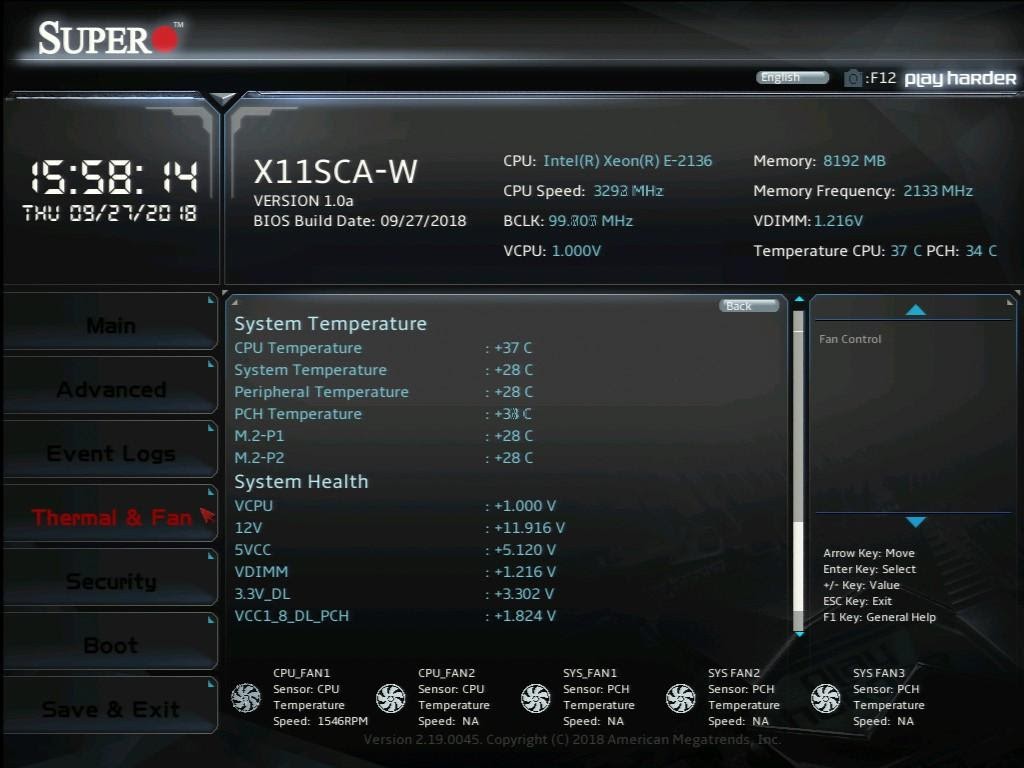
System Temperature
- CPU Temperature
- System Temperature
- Peripheral Temperature
- PCH Temperature
- M.2-P1
- M.2-P2
System Health
- VPU
- 12V
- 5VCC
- VDIMM
- 3.3V_DL
- VCC1_8_DL_PCH
- 3.3VCC
- VSB
- VBAT
- Fan Control
IPMI (Available on X11SCA-F)
IPMI is available on the X11SCA-F. Use this feature to configure Intelligent Platform Management Interface (IPMI) settings.
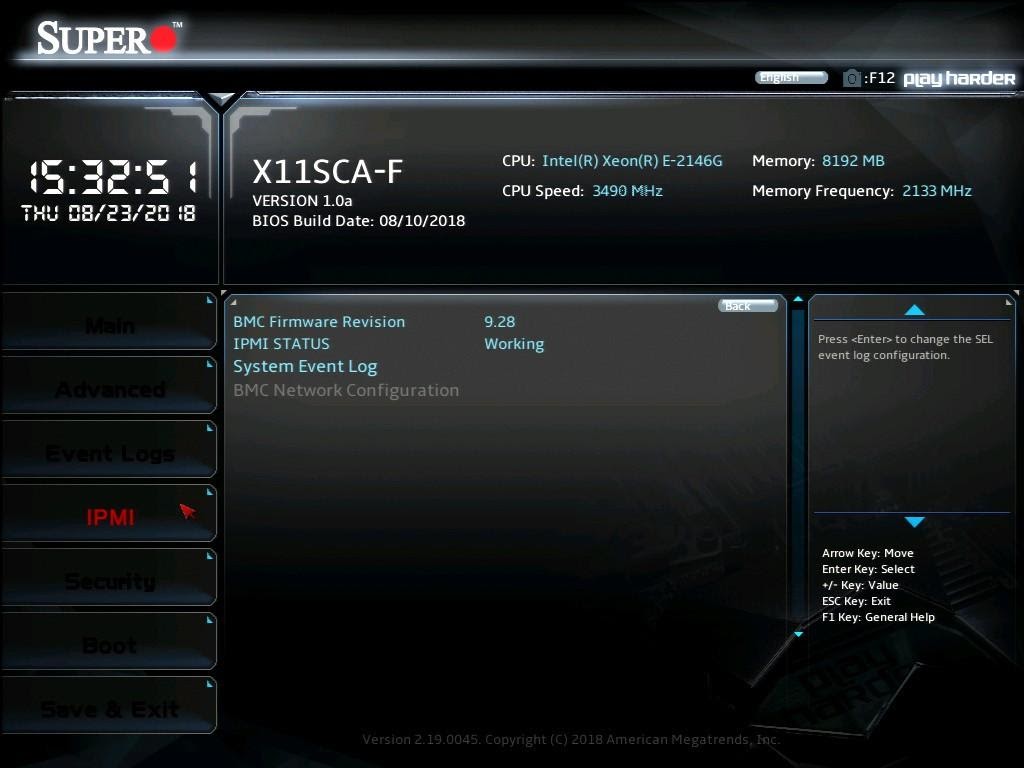
UEFI BIOS Recovery
Warning: Do not upgrade the BIOS unless your system has a BIOS-related issue. Flashing the wrong BIOS can cause irreparable damage to the system. In no event shall Supermicro be liable for direct, indirect, special, incidental, or consequential damages arising from a BIOS update. If you need to update the BIOS, do not shut down or reset the system while the BIOS is updating to avoid possible boot failure.
Overview
The Unified Extensible Firmware Interface (UEFI) provides a software-based interface between the operating system and the platform firmware in the pre-boot environment. The UEFI specification supports an architecture-independent mechanism that will allow the UEFI OS loader stored in an external storage device to boot the system. The UEFI offers a clean, hands-off control to a computer system at bootup.
Recovering the UEFI BIOS Image
A UEFI BIOS flash chip consists of a recovery BIOS block and a main BIOS block (a main BIOS image). The boot block contains critical BIOS codes, including memory detection and recovery codes for the user to flash a new BIOS image if the original main BIOS image is corrupted. When the system power is on, the boot block codes execute first. Once it is completed, the main BIOS code will continue with system initialization and bootup.
Note 1: Follow the BIOS recovery instructions below for BIOS recovery when the main BIOS boot crashes.
Note 2: When the BIOS boot block crashes, you will need to follow the procedures to make a Returned Merchandise Authorization (RMA) request (see Section 3.5 for more information). Also, you may use the Supermicro Update Manager (SUM) Out-of-Band (OOB) https://www.supermicro.com.tw/products/nfo/SMS_SUM.cfm to reflash the BIOS.
Recovering the BIOS Block with a USB Device
This feature allows the user to recover a BIOS image using a USB-attached device without additional utilities used. A USB flash device such as a USB Flash Drive, or a USB CD/DVD ROM/RW device can be used for this purpose. However, a USB Hard Disk drive cannot be used for BIOS recovery at this time.
The file system supported by UEFI is FAT (including FAT12, FAT16, and FAT32) installed on a bootable or non-bootable USB-attached device. However, the BIOS might need several minutes to locate the SUPER.ROM file if the media size becomes too large because it contains too many folders and files.
To perform UEFI BIOS recovery using a USB-attached device, follow the instructions below.
- Using a different machine, copy the “SUPER.ROM” binary image file into the disc Root “\” Directory of a USB device or a writeable CD/DVD.
Note: If you cannot locate the “SUPER.ROM” file in your driver disk, visit our website at www.supermicro.com to download the BIOS image into a USB flash device and rename it to “SUPER.ROM” for BIOS recovery use.![]()
![]()
- Insert the USB device that contains the new BIOS image (“SUPER.ROM”) into your USB drive and power on the system
- After locating the new BIOS binary image, the system will enter the BIOS Recovery menu automatically as shown below.
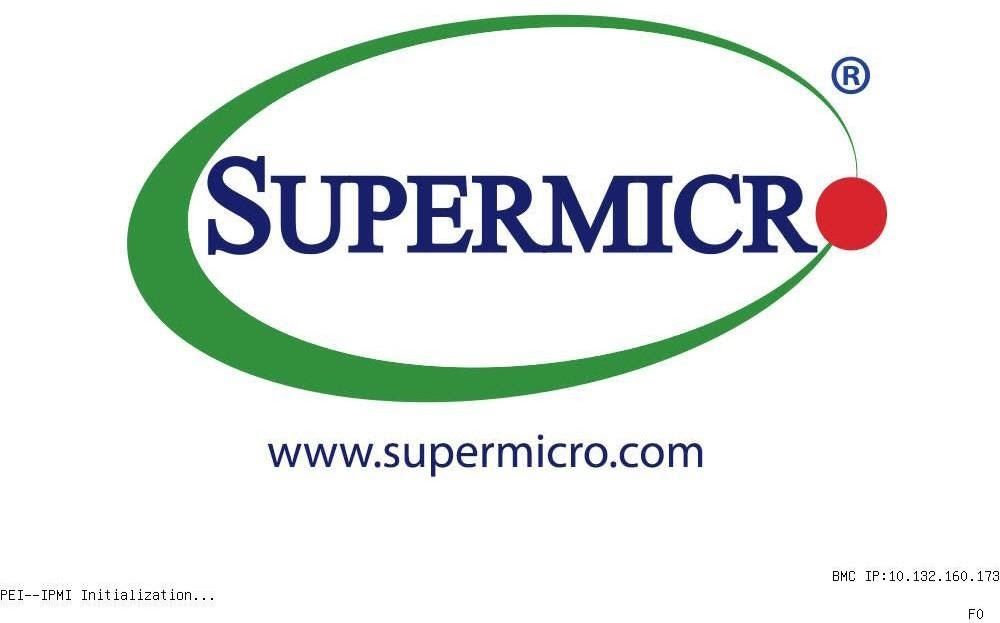
Supermicro X11SCA, X11SCA-W, X11SCA-F User Manual – Supermicro X11SCA, X11SCA-W, X11SCA-F User Manual –
[xyz-ips snippet=”download-snippet”]


